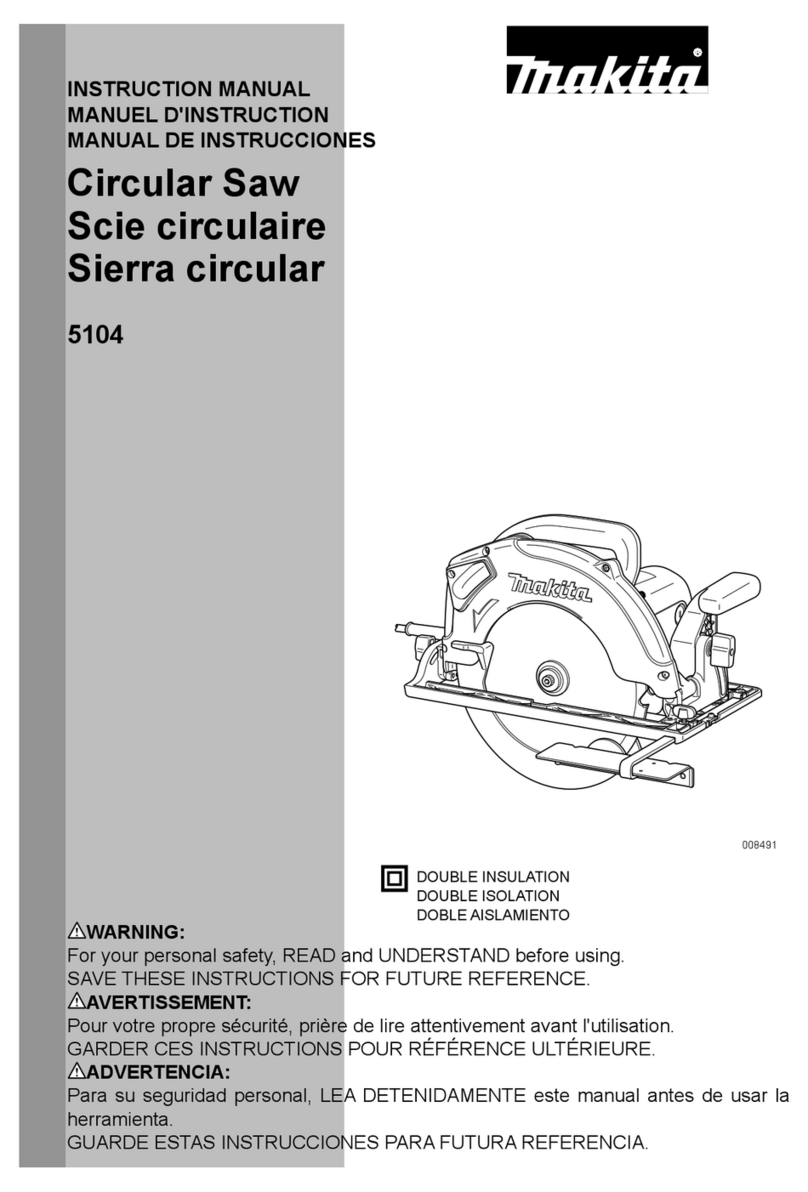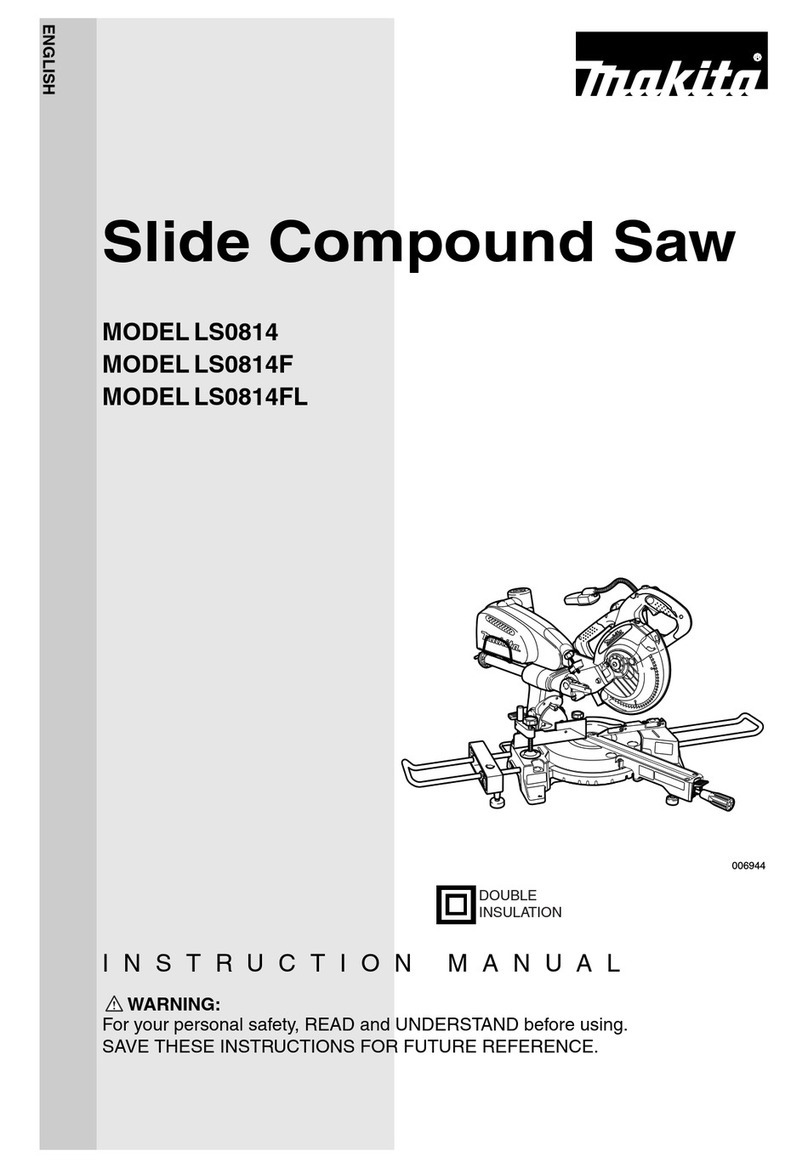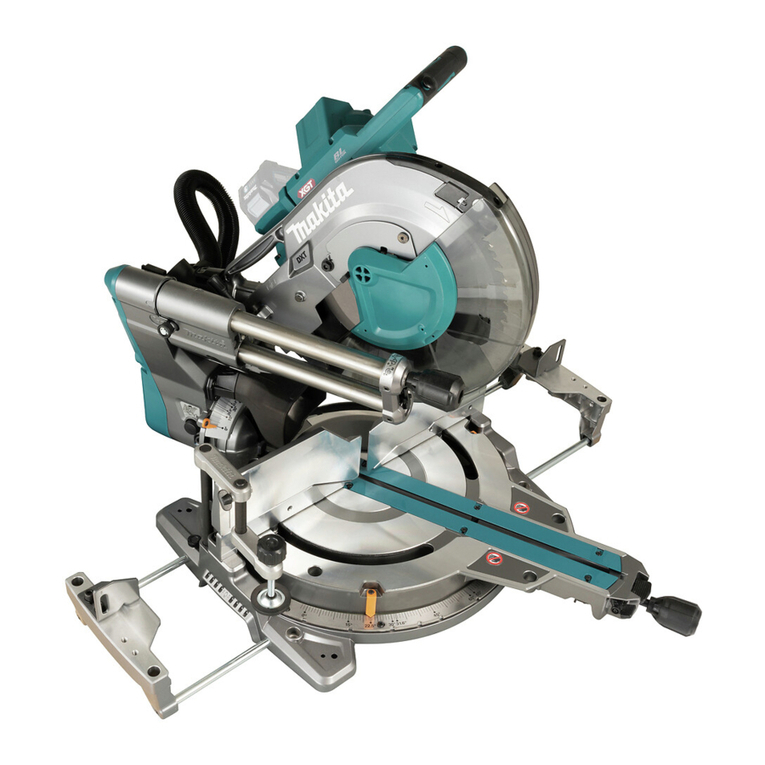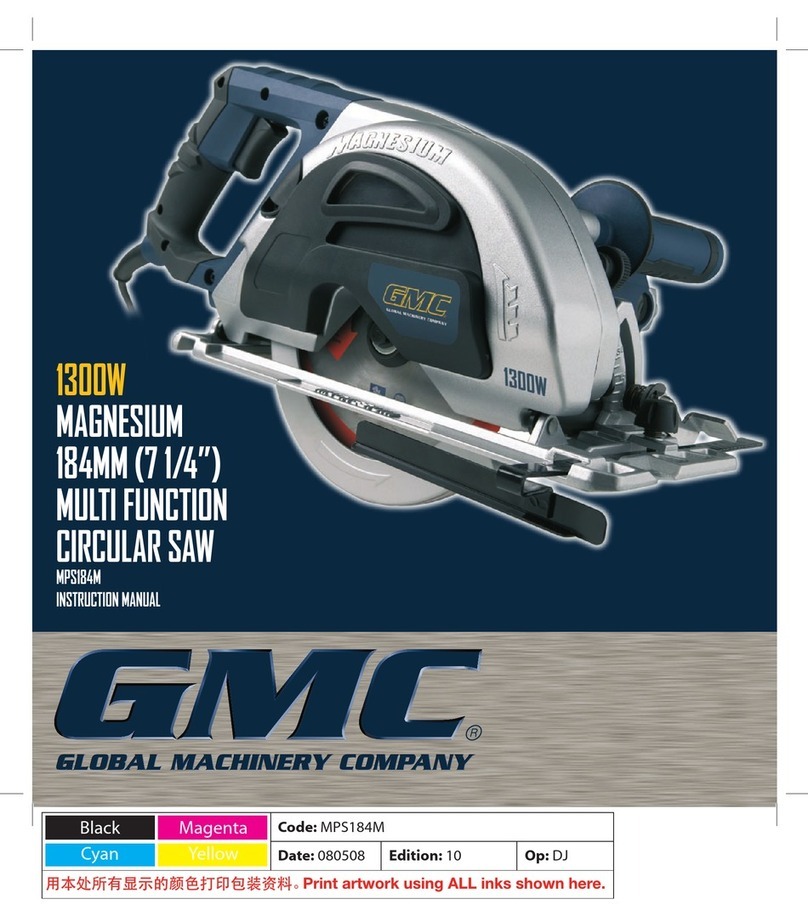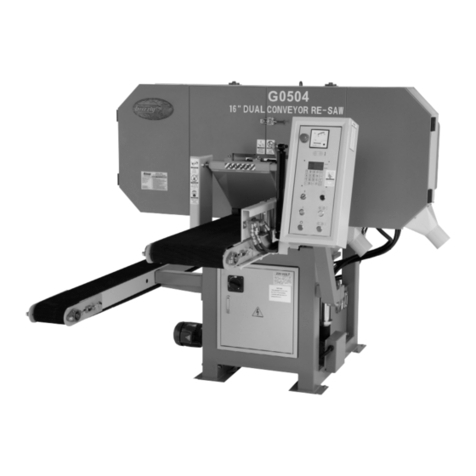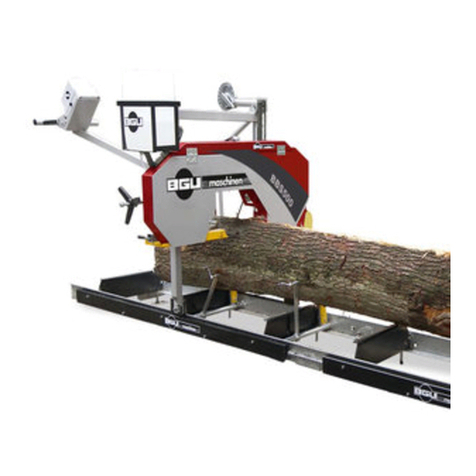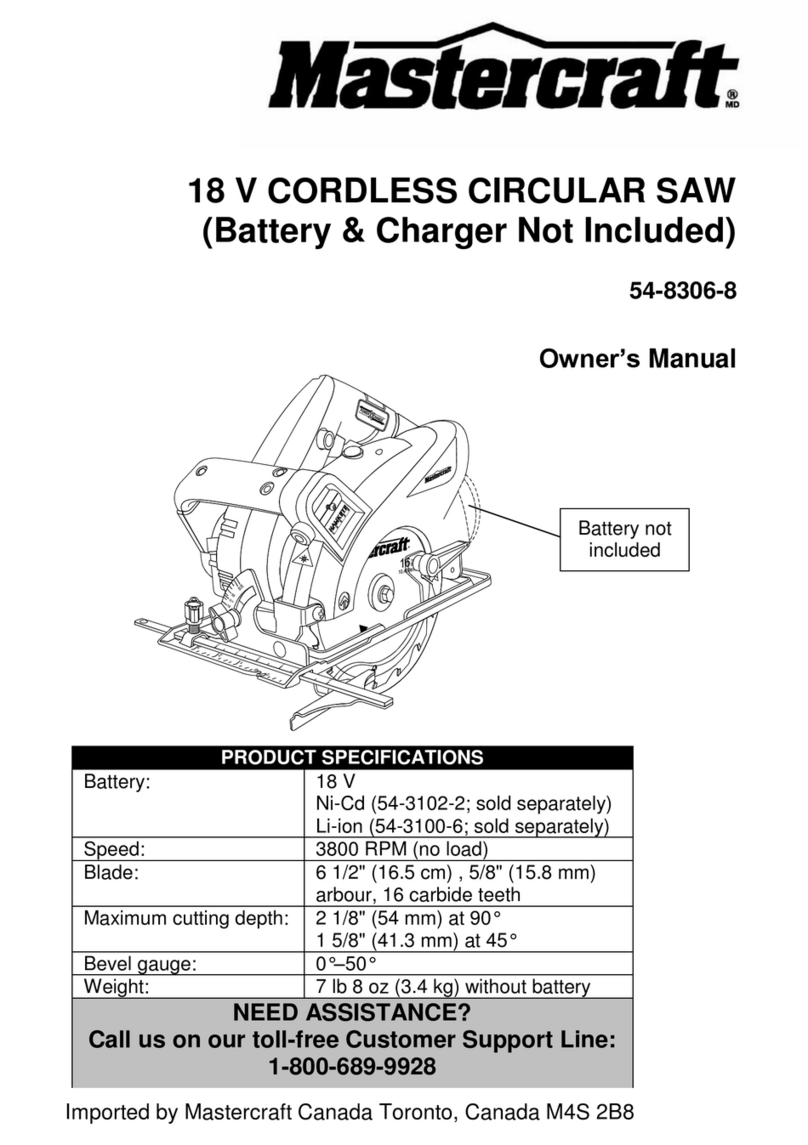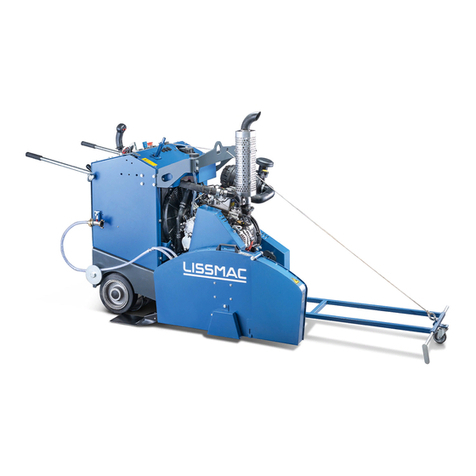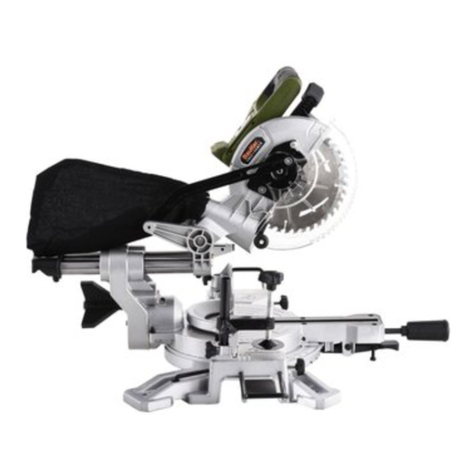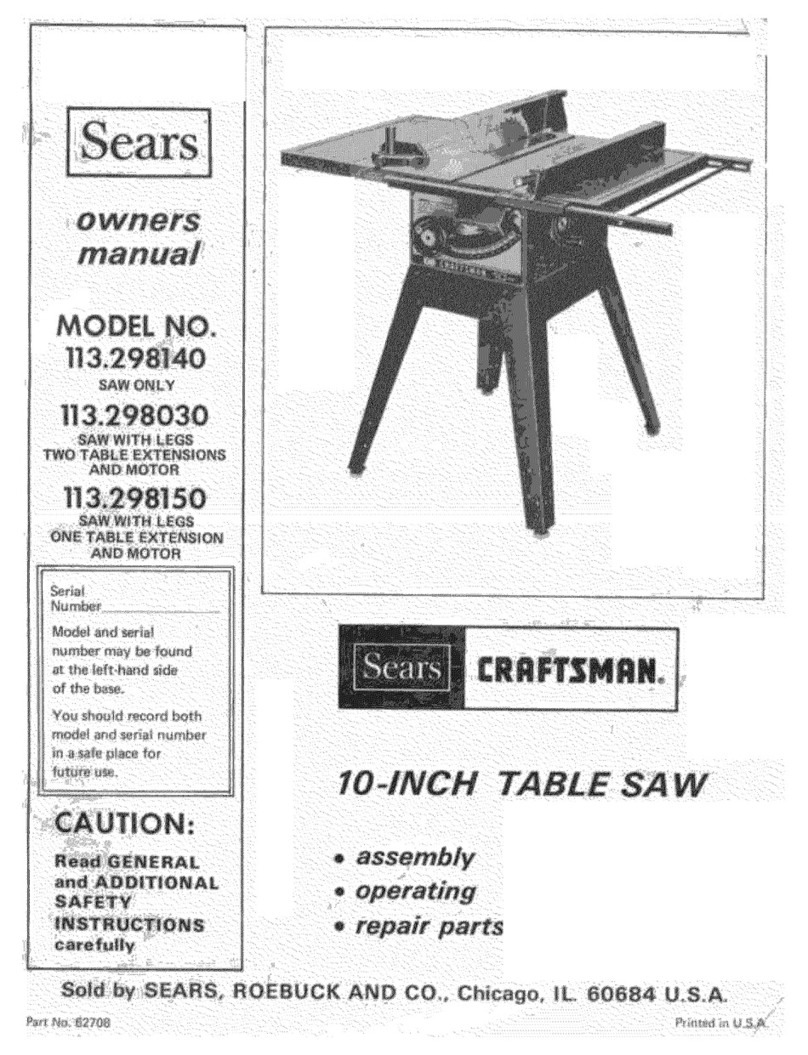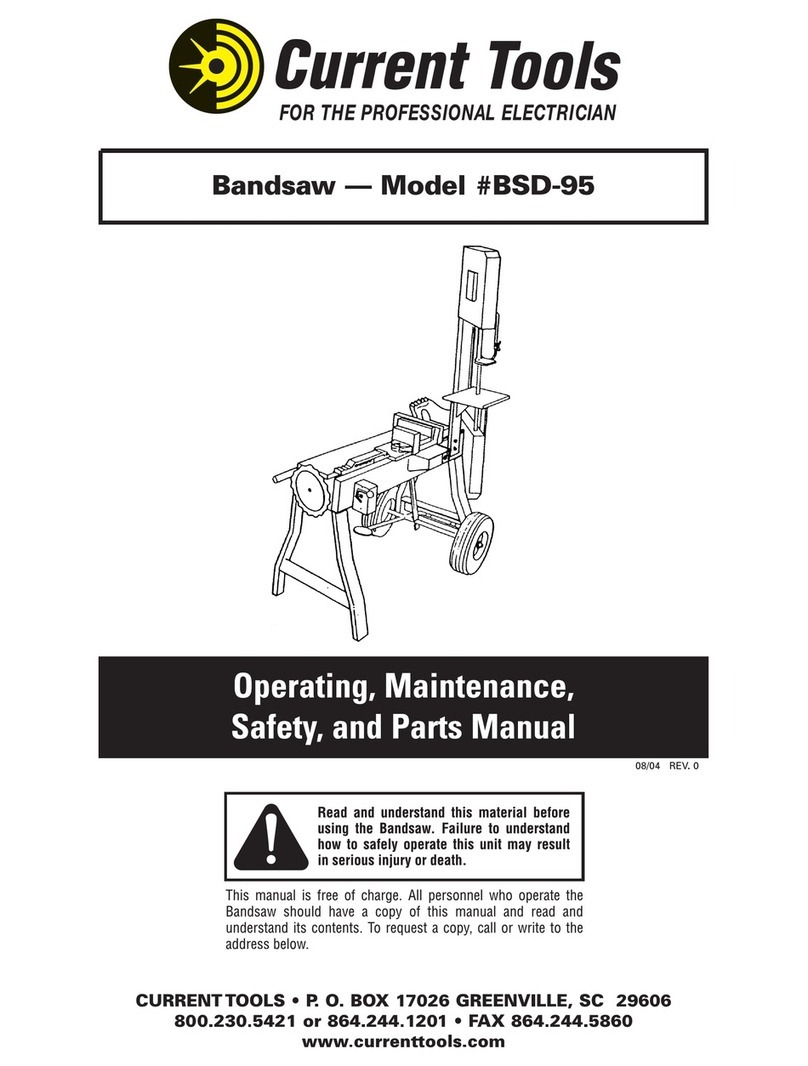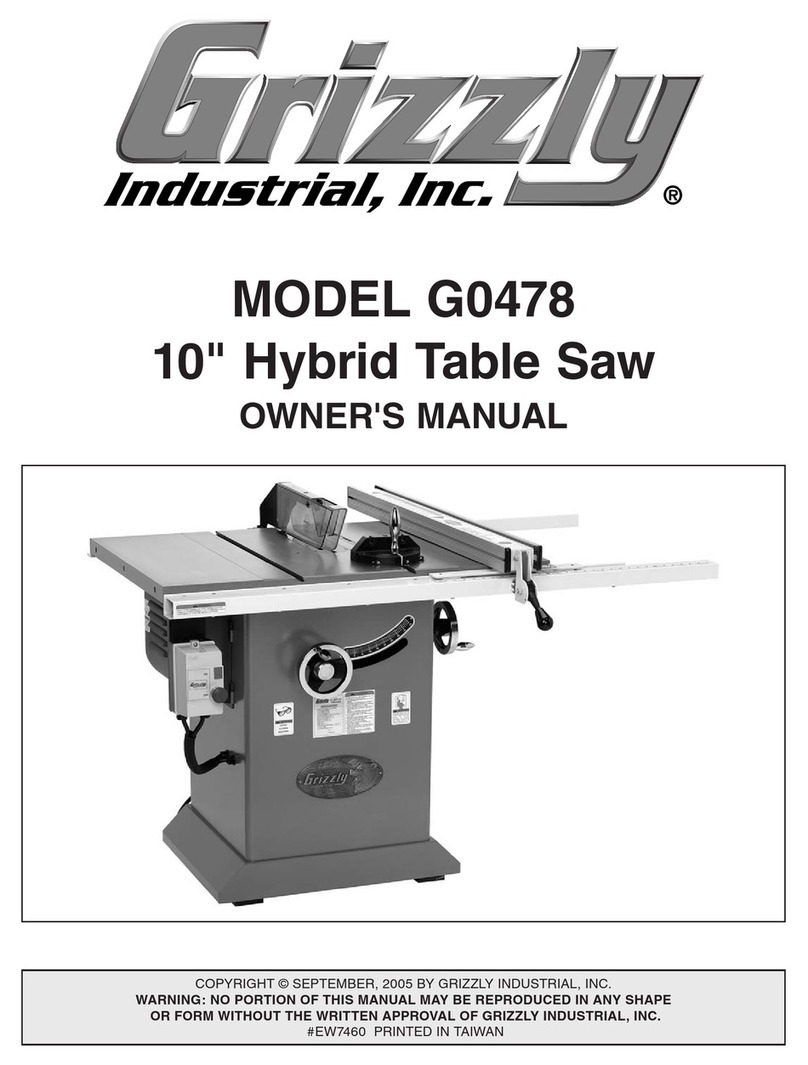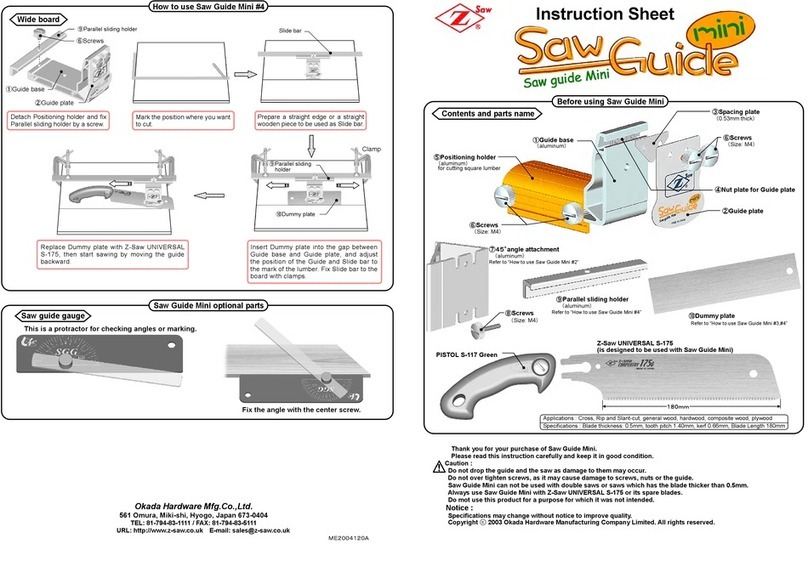Makita 5008MG User manual

5008MG
5008MGA
EN Circular Saw INSTRUCTION MANUAL 5
SL Krožna žaga NAVODILO ZA UPORABO 11
SQ Sharra rrethore MANUALI I PËRDORIMIT 17
BG Циркуляр РЪКОВОДСТВО ЗА
ЕКСПЛОАТАЦИЯ 23
HR Kružna pila PRIRUČNIK S UPUTAMA 30
МК Циркуларна пила УПАТСТВО ЗА УПОТРЕБА 36
RO Ferăstrău circular MANUAL DE INSTRUCŢIUNI 43
SR Кружна тестера УПУТСТВО ЗА УПОТРЕБУ 49
RU Дисковая Пила РУКОВОДСТВО ПО
ЭКСПЛУАТАЦИИ 55
UK Циркулярна пила ІНСТРУКЦІЯ З
ЕКСПЛУАТАЦІЇ 62

21
22.5
45
50
23
1
Fig.1
Fig.2
Fig.3
Fig.4
Fig.5
Fig.6
Fig.7
Fig.8
2

1
BA
1
1
1
2
12
4
1
3
2
5
1
1
2
3
Fig.9
Fig.10
Fig.11
Fig.12
Fig.13
Fig.14
Fig.15
Fig.16
3

1
1
12
1
1
1
2
Fig.17
Fig.18
Fig.19
Fig.20
Fig.21
Fig.22
4

5ENGLISH
ENGLISH (Original instructions)
SPECIFICATIONS
Model 5008MG / 5008MGA
Blade diameter 210 mm
Max. Cutting depth at 90° 75.5 mm
at 45° 57 mm
at 50° 51.5 mm
No load speed (min-1)5,200
Overall length 332 mm
Net weight 4.8 kg
Safety class /II
• Duetoourcontinuingprogramofresearchanddevelopment,thespecicationshereinaresubjecttochange
without notice.
• Specicationsmaydifferfromcountrytocountry.
• Weight according to EPTA-Procedure 01/2014
Intended use
The tool is intended for performing lengthways and
crossways straight cuts and mitre cuts with angles in
woodwhileinrmcontactwiththeworkpiece.With
appropriateMakitagenuinesawblades,othermaterials
canalsobesawed.
Power supply
Thetoolshouldbeconnectedonlytoapowersupplyof
the same voltage as indicated on the nameplate, and
canonlybeoperatedonsingle-phaseACsupply.They
aredouble-insulatedandcan,therefore,alsobeused
from sockets without earth wire.
For public low-voltage distribution systems of
between 220 V and 250 V.
Switching operations of electric apparatus cause volt-
ageuctuations.Theoperationofthisdeviceunder
unfavorablemainsconditionscanhaveadverseeffects
to the operation of other equipment. With a mains
impedanceequalorlessthan0.37Ohmsitcanbepre-
sumedthattherewillbenonegativeeffects.Themains
socketusedforthisdevicemustbeprotectedwitha
fuseorprotectivecircuitbreakerhavingslowtripping
characteristics.
Noise
The typical A-weighted noise level determined accord-
ing to EN62841:
Sound pressure level (LpA) : 95 dB (A)
Sound power level (LWA) : 106 dB (A)
Uncertainty (K) : 3 dB (A)
NOTE: The declared noise emission value(s) has
beenmeasuredinaccordancewithastandardtest
methodandmaybeusedforcomparingonetoolwith
another.
NOTE: The declared noise emission value(s)
mayalsobeusedinapreliminaryassessmentof
exposure.
WARNING: Wear ear protection.
WARNING: The noise emission during actual
use of the power tool can differ from the declared
value(s) depending on the ways in which the
tool is used especially what kind of workpiece is
processed.
WARNING: Be sure to identify safety mea-
sures to protect the operator that are based on an
estimation of exposure in the actual conditions of
use (taking account of all parts of the operating
cycle such as the times when the tool is switched
off and when it is running idle in addition to the
trigger time).
Vibration
Thevibrationtotalvalue(tri-axialvectorsum)deter-
mined according to EN62841:
Work mode : cutting wood
Vibrationemission(ah,W) : 3.0 m/s2
Uncertainty (K) : 1.5 m/s2
Work mode : cutting metal
Vibrationemission(ah,M) : 3.0 m/s2
Uncertainty (K) : 1.5 m/s2
NOTE:Thedeclaredvibrationtotalvalue(s)hasbeen
measured in accordance with a standard test method
andmaybeusedforcomparingonetoolwithanother.
NOTE:Thedeclaredvibrationtotalvalue(s)mayalso
beusedinapreliminaryassessmentofexposure.
WARNING:
The vibration emission during actual
use of the power tool can differ from the declared val-
ue(s) depending on the ways in which the tool is used
especially what kind of workpiece is processed.
WARNING:
Be sure to identify safety measures
to protect the operator that are based on an estimation
of exposure in the actual conditions of use (taking
account of all parts of the operating cycle such as the
times when the tool is switched off and when it is run-
ning idle in addition to the trigger time).

6ENGLISH
EC Declaration of Conformity
For European countries only
The EC declaration of conformity is included as Annex A
to this instruction manual.
General power tool safety warnings
WARNING: Read all safety warnings, instruc-
tions, illustrations and specications provided
with this power tool. Failure to follow all instructions
listedbelowmayresultinelectricshock,reand/or
seriousinjury.
Save all warnings and instruc-
tions for future reference.
The term "power tool" in the warnings refers to your
mains-operated(corded)powertoolorbattery-operated
(cordless) power tool.
Circular saw safety warnings
Cutting procedures
1. DANGER: Keep hands away from cutting
area and the blade. Keep your second hand
on auxiliary handle, or motor housing.Ifboth
handsareholdingthesaw,theycannotbecutby
theblade.
2. Do not reach underneath the workpiece. The
guardcannotprotectyoufromthebladebelowthe
workpiece.
3. Adjust the cutting depth to the thickness of
the workpiece.Lessthanafulltoothoftheblade
teethshouldbevisiblebelowtheworkpiece.
4. Never hold the workpiece in your hands or
across your leg while cutting. Secure the
workpiece to a stable platform. It is important to
supporttheworkproperlytominimisebodyexpo-
sure,bladebinding,orlossofcontrol.
►Fig.1
5. Hold the power tool by insulated gripping
surfaces, when performing an operation where
the cutting tool may contact hidden wiring or
its own cord. Contact with a "live" wire will also
make exposed metal parts of the power tool "live"
and could give the operator an electric shock.
6. When ripping, always use a rip fence or
straight edge guide. This improves the accuracy
ofcutandreducesthechanceofbladebinding.
7. Always use blades with correct size and shape
(diamond versus round) of arbour holes.
Blades that do not match the mounting hardware
of the saw will run off-centre, causing loss of
control.
8. Never use damaged or incorrect blade wash-
ers or bolt.Thebladewashersandboltwere
specially designed for your saw, for optimum
performance and safety of operation.
Kickback causes and related warnings
— kickbackisasuddenreactiontoapinched,
jammedormisalignedsawblade,causingan
uncontrolled saw to lift up and out of the workpiece
toward the operator;
—
whenthebladeispinchedorjammedtightlybythekerf
closingdown,thebladestallsandthemotorreaction
drivestheunitrapidlybacktowardtheoperator;
— ifthebladebecomestwistedormisalignedinthe
cut,theteethatthebackedgeofthebladecandig
intothetopsurfaceofthewoodcausingtheblade
toclimboutofthekerfandjumpbacktowardthe
operator.
Kickbackistheresultofsawmisuseand/orincorrect
operatingproceduresorconditionsandcanbeavoided
bytakingproperprecautionsasgivenbelow.
1. Maintain a rm grip with both hands on the
saw and position your arms to resist kickback
forces. Position your body to either side of the
blade, but not in line with the blade.Kickback
couldcausethesawtojumpbackwards,but
kickbackforcescanbecontrolledbytheoperator,
if proper precautions are taken.
2.
When blade is binding, or when interrupting a cut
for any reason, release the trigger and hold the saw
motionless in the material until the blade comes to
a complete stop. Never attempt to remove the saw
from the work or pull the saw backward while the
blade is in motion or kickback may occur. Investigate
and take corrective actions to eliminate the cause of
bladebinding.
3. When restarting a saw in the workpiece, centre
the saw blade in the kerf so that the saw teeth
are not engaged into the material.Ifasawblade
binds,itmaywalkuporkickbackfromthework-
piece as the saw is restarted.
4. Support large panels to minimise the risk of
blade pinching and kickback. Large panels tend
tosagundertheirownweight.Supportsmustbe
placedunderthepanelonbothsides,neartheline
of cut and near the edge of the panel.
►Fig.2
►Fig.3
5. Do not use dull or damaged blades.
Unsharpenedorimproperlysetbladesproduce
narrowkerfcausingexcessivefriction,blade
bindingandkickback.
6. Blade depth and bevel adjusting locking levers
must be tight and secure before making the
cut.Ifbladeadjustmentshiftswhilecutting,itmay
causebindingandkickback.
7. Use extra caution when sawing into existing
walls or other blind areas.Theprotrudingblade
maycutobjectsthatcancausekickback.
8. ALWAYS hold the tool rmly with both hands.
NEVER place your hand, leg or any part of your
body under the tool base or behind the saw,
especially when making cross-cuts.Ifkickback
occurs,thesawcouldeasilyjumpbackwardsover
yourhand,leadingtoseriouspersonalinjury.
►Fig.4
9. Never force the saw. Push the saw forward at a
speed so that the blade cuts without slowing.
Forcing the saw can cause uneven cuts, loss of
accuracy,andpossiblekickback.
Lower guard function
1. Check the lower guard for proper closing
before each use. Do not operate the saw if the
lower guard does not move freely and close

7ENGLISH
instantly. Never clamp or tie the lower guard
into the open position. If the saw is accidentally
dropped,thelowerguardmaybebent.Raisethe
lower guard with the retracting handle and make
sureitmovesfreelyanddoesnottouchtheblade
or any other part, in all angles and depths of cut.
2.
Check the operation of the lower guard spring. If
the guard and the spring are not operating prop-
erly, they must be serviced before use. Lower guard
may operate sluggishly due to damaged parts, gummy
deposits,orabuild-upofdebris.
3. The lower guard may be retracted manually
only for special cuts such as “plunge cuts”
and “compound cuts”. Raise the lower guard
by the retracting handle and as soon as the
blade enters the material, the lower guard
must be released. For all other sawing, the lower
guard should operate automatically.
4. Always observe that the lower guard is cover-
ing the blade before placing the saw down on
bench or oor.Anunprotected,coastingblade
willcausethesawtowalkbackwards,cutting
whatever is in its path. Be aware of the time it
takesforthebladetostopafterswitchisreleased.
5. To check lower guard, open lower guard by
hand, then release and watch guard closure.
Also check to see that retracting handle does
not touch tool housing.Leavingbladeexposed
isVERYDANGEROUSandcanleadtoserious
personalinjury.
Additional safety warnings
1.
Use extra caution when cutting damp wood, pres-
sure treated lumber, or wood containing knots.
Maintain smooth advancement of tool without decrease
inbladespeedtoavoidoverheatingthebladetips.
2. Do not attempt to remove cut material when
blade is moving. Wait until blade stops before
grasping cut material. Blades coast after turn off.
3. Avoid cutting nails. Inspect for and remove all
nails from lumber before cutting.
4.
Place the wider portion of the saw base on that part
of the workpiece which is solidly supported, not on
the section that will fall off when the cut is made. If
the workpiece is short or small, clamp it down. DO
NOT TRY TO HOLD SHORT PIECES BY HAND!
►Fig.5
5. Before setting the tool down after completing a
cut, be sure that the guard has closed and the
blade has come to a complete stop.
6. Never attempt to saw with the circular saw
held upside down in a vise. This is extremely
dangerous and can lead to serious accidents.
►Fig.6
7.
Some material contains chemicals which may be
toxic. Take caution to prevent dust inhalation and
skin contact. Follow material supplier safety data.
8. Do not stop the blades by lateral pressure on
the saw blade.
9. Do not use any abrasive wheels.
10. Only use the saw blade with the diameter that
is marked on the tool or specied in the man-
ual.Useofanincorrectlysizedblademayaffect
theproperguardingofthebladeorguardopera-
tionwhichcouldresultinseriouspersonalinjury.
11. Keep blade sharp and clean. Gum and wood
pitchhardenedonbladesslowssawand
increasespotentialforkickback.Keepbladeclean
byrstremovingitfromtool,thencleaningitwith
gum and pitch remover, hot water or kerosene.
Never use gasoline.
12. Wear a dust mask and hearing protection when
use the tool.
13. Always use the saw blade intended for cutting
the material that you are going to cut.
14. Only use the saw blades that are marked with
a speed equal or higher than the speed marked
on the tool.
15. (For European countries only)
Always use the blade which conforms to
EN847-1.
SAVE THESE INSTRUCTIONS.
WARNING: DO NOT let comfort or familiarity
with product (gained from repeated use) replace
strict adherence to safety rules for the subject
product. MISUSE or failure to follow the safety
rules stated in this instruction manual may cause
serious personal injury.
FUNCTIONAL
DESCRIPTION
CAUTION:
• Alwaysbesurethatthetoolisswitchedoffand
unpluggedbeforeadjustingorcheckingfunction
on the tool.
Adjusting depth of cut
►Fig.7: 1. Depth guide 2. Lever
CAUTION:
• Afteradjustingthedepthofcut,alwaystighten
the lever securely.
Loosentheleveronthedepthguideandmovethebase
upordown.Atthedesireddepthofcut,securethebase
bytighteningthelever.
For cleaner, safer cuts, set cut depth so that no more
thanonebladetoothprojectsbelowworkpiece.Using
proper cut depth helps to reduce potential for danger-
ousKICKBACKSwhichcancausepersonalinjury.
Bevel cutting
►Fig.8: 1. Lever 2. Positive stopper 3. Arrow on
positive stopper
Positive stopper
Turn the positive stopper so that the arrow on it points
one of three positions (22.5°,45°,50°). Then, tilt the tool
baseuntilitstopsandsecurethebasewiththelever.
At this time, the same angle as the one that the arrow
pointsisobtained.

8ENGLISH
Setting bevel angle
Loosentheleverandtentativelysetthetoolbaseatthe
0°bevelangle,thentightentheleversecurely.
Turn the positive stopper so that the arrow on it points
one of three positions (22.5°,45°,50°) that is equal to or
greaterthanthedesiredbevelangle.
Loosen the lever again and then tilt and secure the tool
baseatthedesiredanglesecurely.
NOTE:
• When changing the positive stopper's position,
looseningtheleverandtiltingthebevelangleto
lessthanthedesiredstopperpositionnumber
allows to change it.
• When the arrow on the positive stopper points
22.5,thebevelanglecanbeadjusted0-22.5°;
whenthearrowpoints45,itcanbeadjusted
0-45°;whenthearrowpoints50,itcanbe
adjusted0-50°.
Sighting
►Fig.9: 1. Base
For straight cuts, align the A position on the front of the
basewithyourcuttingline.For45°bevelcuts,alignthe
B position with it.
Switch action
►Fig.10: 1. Switch trigger
CAUTION:
• Before plugging in the tool, always check to see
that the switch trigger actuates properly and
returns to the "OFF" position when released.
Tostartthetool,simplypulltheswitchtrigger.Release
the switch trigger to stop.
Lighting the lamp
►Fig.11: 1. Lamp
CAUTION:
• Do not apply impact to the lamp, which may
cause damage or shorted service time to it.
• Do not look in the light or see the source of light
directly.
The lamp lights up when the tool is plugged. The lamp
keeps on lighting until the tool is unplugged.
If the lamp does not light up, the mains cord or the lamp
maybedefective.Thelampislitbutthetooldoesnot
startevenifthetoolisswitchedon,thecarbonbrushes
maybewornout,orthemotorortheON/OFFswitch
maybedefective.
NOTE:
• Use a dry cloth to wipe the dirt off the lens of
lamp. Be careful not to scratch the lens of lamp,
or it may lower the illumination.
ASSEMBLY
CAUTION:
• Alwaysbesurethatthetoolisswitchedoffand
unpluggedbeforecarryingoutanyworkonthe
tool.
Hex wrench storage
►Fig.12: 1. Hex wrench 2. Protrusion
Hex wrench is stored on the tool. To remove hex
wrench, rotate it toward yourself and pull it out.
To install hex wrench, place it on the handle and turn
it until it comes into contact with the protrusion on the
handle.
Removing or installing saw blade
►Fig.13: 1. Hex wrench 2. Shaft lock
CAUTION:
• Besurethebladeisinstalledwithteethpointing
up at the front of the tool.
• Use only the Makita wrench to install or remove
theblade.
Toremovetheblade,presstheshaftlocksothatthe
bladecannotrevolveandusethehexwrenchtoloosen
thehexboltcounterclockwise.Thenremovethehex
bolt,outerangeandblade.
Toinstalltheblade,followtheremovalprocedurein
reverse.BESURETOTIGHTENTHEHEXBOLT
CLOCKWISESECURELY.
►Fig.14: 1.Sawblade2.Hexbolt3.Outerange
4.Innerange5.Ring
Whenchangingblade,makesuretoalsocleanthe
upperandlowerbladeguardsofaccumulatedsawdust
as discussed in the Maintenance section. Such efforts
do not replace the need to check lower guard operation
beforeeachuse.
Connecting a vacuum cleaner
Optional accessory
►Fig.15: 1. Vacuum cleaner
When you wish to perform clean cutting operation,
connect a Makita vacuum cleaner to your tool. Install
thejointonthetoolusingthescrews.Thenconnecta
hoseofthevacuumcleanertothejointasshowninthe
gure.
OPERATION
CAUTION:
• Be sure to move the tool forward in a straight
line gently. Forcing or twisting the tool will result
in overheating the motor and dangerous kick-
back,possiblycausingsevereinjury.
►Fig.16: 1.Rearhandle2. Front grip 3. Base
Alwaysuseafrontgripandrearhandleandrmlyhold
thetoolbyboththefrontgripandrearhandleduring

9ENGLISH
operations.Thetoolisprovidedwithboththefrontgrip
andrearhandle.Ifbothhandsareholdingsaw,they
cannotbecutbytheblade.Setthebaseonthework-
piecetobecutwithouttheblademakinganycontact.
Thenturnthetoolonandwaituntilthebladeattains
full speed. Now simply move the tool forward over
theworkpiecesurface,keepingitatandadvancing
smoothly until the sawing is completed.
To get clean cuts, keep your sawing line straight and
your speed of advance uniform. If the cut fails to prop-
erly follow your intended cut line, do not attempt to turn
orforcethetoolbacktothecutline.Doingsomaybind
thebladeandleadtodangerouskickbackandpossible
seriousinjury.Releaseswitch,waitforbladetostop
andthenwithdrawtool.Realigntoolonnewcutline,
and start cut again. Attempt to avoid positioning which
exposesoperatortochipsandwooddustbeingejected
fromsaw.Useeyeprotectiontohelpavoidinjury.
Rip fence (guide rule) (Accessory)
►Fig.17: 1.Ripfence(Guiderule)
The handy rip fence allows you to do extra-accurate
straight cuts. Simply slide the rip fence up snugly
against the side of the workpiece and secure it in
positionwiththescrewonthefrontofthebase.Italso
makesrepeatedcutsofuniformwidthpossible.
Lanyard (tether strap) connection
Safety warnings specic for use at height
Read all safety warnings and instructions. Failure
to follow the warnings and instructions may result in
seriousinjury.
1. Always keep the tool tethered when working
"at height". Maximum lanyard length is 2 m
(6.5 ft).
2. Use only with lanyards appropriate for this tool
type and rated for at least 6.0 kg (13.3 lbs).
3. Do not anchor the tool lanyard to anything on
your body or on movable components. Anchor
the tool lanyard to a rigid structure that can
withstand the forces of a dropped tool.
4. Make sure the lanyard is properly secured at
each end prior to use.
5. Inspect the tool and lanyard before each use
for damage and proper function (including
fabric and stitching). Do not use if damaged or
not functioning properly.
6. Do not wrap lanyards around or allow them to
come in contact with sharp or rough edges.
7. Fasten the other end of the lanyard outside
the working area so that a falling tool is held
securely.
8. Attach the lanyard so that the tool will move
away from the operator if it falls. Dropped tools
willswingonthelanyard,whichcouldcauseinjury
orlossofbalance.
9. Do not use near moving parts or running
machinery. Failure to do so may result in a crush
or entanglement hazard.
10. Do not carry the tool by the attachment device
or the lanyard.
11. Only transfer the tool between your hands
while you are properly balanced.
12. Do not attach lanyards to the tool in a way that
keeps guards, switches or lock-offs from oper-
ating properly.
13. Avoid getting tangled in the lanyard.
14. Keep lanyard away from the cutting area of the
tool.
15. Use multi-action and screw gate type cara-
bineers. Do not use single action spring clip
carabineers.
16. In the event the tool is dropped, it must be
tagged and removed from service, and should
be inspected by a Makita Factory or Authorized
Service Center.
►Fig.18: 1. Hole for lanyard (tether strap)
MAINTENANCE
CAUTION:
• Alwaysbesurethatthetoolisswitchedoffand
unpluggedbeforeattemptingtoperforminspec-
tion or maintenance.
• Clean out the upper and lower guards to
ensure there is no accumulated sawdust
which may impede the operation of the lower
guarding system.A dirty guarding system may
limit the proper operation which could result in
seriouspersonalinjury.Themosteffectiveway
to accomplish this cleaning is with compressed
air. If the dust is being blown out of the
guards be sure the proper eye and breathing
protection is used.
• Neverusegasoline,benzine,thinner,alcohol
or the like. Discoloration, deformation or cracks
may result.
Adjusting for accuracy of 90° cut
(vertical cut)
Thisadjustmenthasbeenmadeatthefactory.Butifitis
off,adjusttheadjustingscrewwithahexwrenchwhile
squaringthebladewiththebaseusingatriangularrule,
try square, etc.
►Fig.19: 1. Base 2.Adjustingscrew
►Fig.20: 1. Triangular rule
Replacing carbon brushes
►Fig.21: 1. Limit mark
Removeandcheckthecarbonbrushesregularly.
Replacewhentheyweardowntothelimitmark.Keep
thecarbonbrushescleanandfreetoslipintheholders.
Bothcarbonbrushesshouldbereplacedatthesame
time.Useonlyidenticalcarbonbrushes.
Useascrewdrivertoremovethebrushholdercaps.
Takeouttheworncarbonbrushes,insertthenewones
andsecurethebrushholdercaps.
►Fig.22: 1. Brush holder cap 2. Screwdriver
TomaintainproductSAFETYandRELIABILITY,repairs,
anyothermaintenanceoradjustmentshouldbeper-
formedbyMakitaAuthorizedServiceCenters,always
using Makita replacement parts.

10 ENGLISH
For model 5008MGA only
Afterreplacingbrushes,pluginthetoolandbreakin
brushesbyrunningtoolwithnoloadforabout10min-
utes. Then check the tool while running and electric
brakeoperationwhenreleasingtheswitchtrigger.If
electricbrakeisnotworkingwell,askyourlocalMakita
service center for repair.
OPTIONAL
ACCESSORIES
CAUTION:
• These accessories or attachments are recom-
mendedforusewithyourMakitatoolspecied
in this manual. The use of any other accessories
orattachmentsmightpresentariskofinjuryto
persons. Only use accessory or attachment for
its stated purpose.
If you need any assistance for more details regard-
ing these accessories, ask your local Makita Service
Center.
• Steel&Carbide-tippedsawblades
Combination General purpose blade for fast and smooth rip,
crosscuts and miters.
Pressure treated/
Wet lumber
Designed for fast cutting of pressure treated and
wet lumber.
Fine cross cuts For sand-free cuts cleanly against the grain.
• Ripfence(Guiderule)
• Hex wrench
• Dustnozzle(joint)
NOTE:
• Someitemsinthelistmaybeincludedinthe
tool package as standard accessories. They
may differ from country to country.

11 SLOVENŠČINA
SLOVENŠČINA (Originalna navodila)
TEHNIČNI PODATKI
Model 5008MG / 5008MGA
Premer rezila 210 mm
Maks.globinarezanja pri 90° 75,5 mm
pri 45° 57 mm
pri 50° 51,5 mm
Hitrostbrezobremenitve(min-1)5.200
Celotnadolžina 332 mm
Netoteža 4,8 kg
Varnostni razred /II
• Kernenehnoopravljamoraziskaveinrazvijamosvojeizdelke,selahkotehničnipodatkivtemdokumentu
spremenijobrezobvestila.
• Tehničnipodatkiselahkorazlikujejooddržavedodržave.
• TežavskladuspostopkomEPTA01/2014
Namenska uporaba
Orodjejenamenjenozaizvajanjevzdolžnihinprečnih
ravnihinzajeralnihrezovpodkotomvles,medtemko
jetrdnopritisnjenoobobdelovanca.Zustreznimiori-
ginalnimižaginimilistiMakitalahkožagatetudidruge
materiale.
Priključitev na električno omrežje
Napetostelektričnegaomrežjasemoraujematis
podatkinatipskiploščici.Strojdelujesamozenofazno
izmeničnonapetostjo.Strojjepoevropskihsmernicah
dvojnozaščitnoizoliran,zatosegalahkopriključitudi
navtičnicebrezozemljitvenegavoda.
Za javna nizkonapetostna električna omrežja z
napetostjo med 220 V in 250 V.
Vklopiinizklopielektričnihaparatovpovzročajonihanje
električnenapetosti.Delovanjetenapravevneugod-
nihomrežnihpogojihimalahkoneugodneučinkena
delovanjedrugihpriključenihnaprav.Priimpedanci
omrežjado0,37Ohmajemožnopredpostaviti,dane
bonegativnihučinkov.Omrežnavtičnica,nakaterobo
priključenatanaprava,morabitizaščitenazvarovalko
alistokovnimzaščitnimstikalomspočasnokarakteri-
stikoproženja.
Hrup
Tipični,zAocenjenivrednostihrupagledenaEN62841:
Ravenzvočnegatlaka(LpA): 95 dB (A)
Ravenzvočnemoči(LWA): 106 dB (A)
Odstopanje(K):3dB(A)
OPOMBA:Navedenevrednostioddajanjahrupaso
bileizmerjenevskladusstandardnimimetodami
testiranjainselahkouporabljajozaprimerjavoorodij.
OPOMBA:Navedenevrednostioddajanjahrupa
selahkouporabljajotudipripredhodnioceni
izpostavljenosti.
OPOZORILO: Uporabljajte zaščito za sluh.
OPOZORILO: Oddajanje hrupa med dejansko
uporabo električnega orodja se lahko razlikuje od
navedenih vrednosti, odvisno od načina uporabe
orodja in predvsem vrste obdelovanca.
OPOZORILO: Upravljavec mora za lastno
zaščito poznati varnostne ukrepe, ki temeljijo
na oceni izpostavljenosti v dejanskih pogojih
uporabe (poleg časa proženja je treba upoštevati
celoten delovni cikel, vključno s časom, ko je
orodje izklopljeno, in časom, ko deluje v prostem
teku).
Vibracije
Skupnevrednostivibracij(vektorskavsotatrehosi)po
EN62841:
Delovninačin:rezanjelesa
Oddajanjetresljajev(ah,W): 3,0 m/s2
Odstopanje(K):1,5m/s2
Delovninačin:rezanjekovine
Oddajanjetresljajev(ah,M): 3,0 m/s2
Odstopanje(K):1,5m/s2
OPOMBA:
Navedeneskupnevrednostioddajanjavibracij
sobileizmerjenevskladusstandardnimimetodamitestira-
njainselahkouporabljajozaprimerjavoorodij.
OPOMBA:Navedeneskupnevrednostioddajanja
vibracijselahkouporabljajotudipripredhodnioceni
izpostavljenosti.
OPOZORILO:
Oddajanje vibracij med dejansko
uporabo električnega orodja se lahko razlikuje od nave-
denih vrednosti, odvisno od načina uporabe orodja in
predvsem vrste obdelovanca.
OPOZORILO:
Upravljavec mora za lastno zaš-
čito poznati varnostne ukrepe, ki temeljijo na oceni
izpostavljenosti v dejanskih pogojih uporabe (poleg
časa proženja je treba upoštevati celoten delovni cikel,
vključno s časom, ko je orodje izklopljeno, in časom, ko
deluje v prostem teku).

12 SLOVENŠČINA
Izjava o skladnosti ES
Samo za evropske države
IzjavaESoskladnostijevključenavdodatkuA,kije
priložentemnavodilomzauporabo.
Splošna varnostna opozorila za
električno orodje
OPOZORILO: Preberite vsa varnostna opo-
zorila in navodila s slikami in tehničnimi podatki,
ki so dobavljeni skupaj z električnim orodjem.
Obneupoštevanjuspodajnavedenihnavodilobstaja
nevarnostelektričnegaudara,požarain/alihudih
telesnihpoškodb.
Shranite vsa opozorila in navo-
dila za poznejšo uporabo.
Izraz„električnoorodje“vopozorilihsenanašanavaše
električnoorodje(skablom)alibaterijskoelektrično
orodje(brezkabla).
Varnostna opozorila za uporabo
krožne žage
Postopki rezanja
1. NEVARNOST: Ne približujte rok območju
rezanja in rezilu. Drugo roko imejte na pomož-
nem ročaju ali ohišju motorja.Čedržitežagoz
obemarokama,jurezilonemorepoškodovati.
2. Ne segajte pod obdelovanca.Ščitnikvaspod
obdelovancemnemorevarovatipredrezilom.
3. Prilagodite globino rezanja debelini obdelo-
vanca.Podobdelovancemnesmebitividnaveč
kotenadolžinazobca.
4.
Med rezanjem nikoli ne držite obdelovanca v rokah
ali prek nog. Pritrdite obdelovanec na stabilno
podlago.Pomembnoje,dajeobdelovanecustrezno
podprt,dazmanjšateizpostavljenosttelesatermožnost
zagozditverezilaaliizgubenadzora.
►Sl.1
5. Če obstaja nevarnost, da bi z rezilnim orodjem
prerezali skrito električno napeljavo ali lasten
kabel, držite električno orodje na izoliranih
držalnih površinah.Čepridedostikazvodniki
podnapetostjo,sopodnapetostjovsineizolirani
kovinskidelielektričnegaorodja,zaradičesar
lahkouporabnikutrpielektričniudar.
6. Med vzporednim rezanjem vedno uporabite
vzporedni prislon ali vodilo z ravnim robom. S
tembosteizboljšalinatančnostrezainzmanjšali
možnostzagozditverezila.
7. Vedno uporabljajte rezila prave velikosti in
oblike osnih lukenj (diamantna ali krožna).
Rezila,kijihnimogočeustreznonamestitina
orodje,bododelovalaekscentrično,karbo
povzročiloizgubonadzora.
8. Nikoli ne uporabljajte poškodovanih ali nepra-
vilnih tesnil ali vijakov rezila.Tesnilainvijaki
rezilasobilaposebejnarejenazavašožago,da
zagotovijooptimalnoučinkovitostinvarnostpri
delu.
Vzroki za povratni udarec in s tem povezana
opozorila
— povratniudarecjenenadnareakcijapristisnje-
nem,zagozdenemalineporavnanemžaginem
listu,kipovzročinenadzorovandvigžageizobde-
lovancaprotiupravljavcu;
— čejerezilostisnjenoalitrdnozagozdenovzapi-
rajočisešpranji,seustaviinreakcijamotorjahitro
vržeenotonazajprotiupravljavcu;
— česerezilomedrezomzvijealijenapačno
poravnano,selahkozobcinazadnjemroburezila
zataknejovzgornjopovršinolesa,karpovzroči,da
rezilopadeizšpranjeinskočiprotiupravljavcu.
Povratniudarecjeposledicanestrokovnegaravnanja
zžagoin/alineugodnihokoliščin.Preprečitegalahkoz
upoštevanjemspodajnavedenihopozoril.
1. Trdno držite žago z obema rokama in name-
stite roki, da se uprete silam povratnega
udarca. Namestite telo na katero koli stran
rezila in ne poravnano z rezilom. Povratni uda-
reclahkopovzročiskokžagenazaj,vendarlahko
silepovratnegaudarcaupravljavecnadzoruje,če
izvede pravilne varnostne ukrepe.
2. Ko se rezilo zatakne ali če iz katerega koli
razloga prekinete z rezanjem, spustite spro-
žilnik in negibno držite žago v materialu,
dokler se rezilo popolnoma ne ustavi. Nikoli
ne skušajte odstraniti žage iz obdelovanca in
je ne poskušajte povleči nazaj, dokler se žaga
premika. V nasprotnem primeru lahko pride do
povratnega udarca. Preverite in odpravite vzrok
oviranjarezila.
3. Kadar ponovno zaganjate žago v obdelovancu,
poravnajte žagin list v špranji, tako da žagini
zobci niso zagozdeni v materialu.Česežagin
listzagozdi,selahkopremaknealiudariizobdelo-
vanca,koznovazaženetežago.
4. Pod velike plošče postavite podporo, da
zmanjšate možnost zagozdenja rezila ali
povratnega udarca.Velikeploščeselahkozaradi
lastnetežepovesijo.Podporejetrebapostaviti
podploščonaobehstranehvbližinilinijerezain
blizurobaplošče.
►Sl.2
►Sl.3
5. Ne uporabljajte topih ali poškodovanih rezil.
Nenabrušenaalinepravilnonastavljenarezila
naredijoozkošpranjo,karpovzročičezmerno
trenje,zagozdenjerezilainpovratniudarec.
6. Ročici za nastavljanje globine reza in prila-
goditev poševnosti morata biti trdno in varno
pritrjeni pred začetkom rezanja.Česeprilago-
jenipoložajrezilamedrezanjemspremeni,lahko
povzročioviranjeinpovratniudarec.
7. Bodite še posebej previdni, kadar režete v
obstoječe stene ali druga slepa območja.
Rezilolahkoprerežepredmete,kilahkopovzročijo
povratni udarec.
8. VEDNO trdno držite orodje z obema rokama.
NIKOLI ne polagajte rok, nog ali katerega
koli drugega dela telesa pod osnovno ploščo
orodja ali za žago, zlasti kadar izvajate prečne
reze.Vprimerupovratnegaudarcalahkožaga
odskočinazajprekovašerokeinpovzročihude
telesnepoškodbe.

13 SLOVENŠČINA
►Sl.4
9. Nikoli ne pritiskajte žage. Potisnite žago naprej
s hitrostjo, pri kateri rezilo reže brez upočas-
njevanja.Pritiskanjenažagolahkopovzroči
neravnereze,nenatančnostinmorebitenpovratni
udarec.
Funkcija ščitnika
1. Pred vsako uporabo preverite, če se spodnji
ščitnik pravilno zapira. Ne uporabljajte žage,
če se spodnji ščitnik ne premika prosto in se
ne zapira. Nikoli ne pritrjujte ali privezujte spo-
dnjega ščitnika v odprtem položaju.Čevam
žagaponesrečipade,selahkospodnjiščitnik
zvije.Dvignitespodnjiščitnikzzategovalnoročico
inseprepričajte,daseprostopremikainsene
dotika rezila ali katerega koli dela pri vseh kotih in
globinahreza.
2. Preverite delovanje vzmeti spodnjega ščitnika.
Če ščitnik in vzmet ne delujeta pravilno, ju je
treba pred uporabo servisirati.Spodnjiščitnik
lahkodelujepočasizaradipoškodovanihdelov,
ostankovgumealinabranihostružkov.
3. Spodnji ščitnik lahko ročno odmaknete samo
pri posebnih rezih, kot so „ugreznjeni rezi“
in „sestavljeni rezi“. Dvignite spodnji ščitnik,
tako da povlečete ročico, ko pa rezilo vstopi
v material, je treba spodnji ščitnik spustiti. Pri
vsehdrugihnačinihžaganjamoraspodnjiščitnik
delovatisamodejno.
4. Preden odložite žago na mizo ali tla, vedno
pazite, da spodnji ščitnik pokriva rezilo.
Nezaščitenorezilovprostemtekubopovzročilo
premikžagenazaj,kiborezalavse,karjibo
napoti.Upoštevajtečas,kijepotrebenzazausta-
vitev rezila, ko izpustite stikalo.
5. Delovanje spodnjega ščitnika preverite tako,
da ga ročno odprete, izpustite in opazujete
zapiranje. Prav tako se prepričajte, da se
zategovalna ročica ne dotika ohišja orodja.
Odlaganjeorodjaznezaščitenimrezilomje
ZELONEVARNOinlahkopovzročihudetelesne
poškodbe.
Dodatna varnostna opozorila
1. Bodite posebej previdni pri rezanju vlažnega
lesa, s tlakom obdelanega lesa ali grčavega
lesa.Orodjemoranapredovatigladkobrezzmanj-
šanjahitrostirezila,dasepreprečipregrevanje
konice rezila.
2. Ne poskušajte odstraniti odrezanega mate-
riala, medtem ko se rezilo premika. Preden
primete rezan material, počakajte, da se rezilo
ustavi.Rezilojepoizklopuvprostemteku.
3. Izogibajte se rezanju žebljev. Pred rezanjem
poiščite vse žeblje in jih odstranite iz lesa.
4. Širši del podstavka žage postavite na tisti
del obdelovanca, ki je trdno podprt, in ne
na del, ki bo po končanem rezu odpadel. Če
je obdelovanec kratek ali majhen, ga pritr-
dite. NE POSKUŠAJTE DRŽATI KRATKEGA
OBDELOVANCA V ROKI!
►Sl.5
5. Pred odložitvijo orodja po končanem rezu se
prepričajte, da se je ščitnik zaprl in se je rezilo
popolnoma ustavilo.
6. Nikoli ne poskušajte žagati s krožno žago,
tako da jo vpnete v primež obrnjeno na glavo.
To je izjemno nevarno in lahko povzroči hudo
nesrečo.
►Sl.6
7. Nekateri materiali vsebujejo kemikalije, ki so
lahko strupene. Bodite previdni ter preprečite
vdihavanje prahu in stik s kožo. Upoštevajte
varnostne podatke dobavitelja materiala.
8. Ne zaustavljajte rezila z bočnim pritiskom na
žagin list.
9. Ne uporabljajte abrazivnih plošč.
10. Uporabljajte le rezila žage s premerom, ki je
označen na orodju ali naveden v priročniku.
Uporabarezilanepravilnevelikostilahkovpliva
naustreznozaščitorezilaalidelovanješčit-
nika,zaradičesarlahkopridedohudihtelesnih
poškodb.
11. Rezilo mora biti ostro in čisto. Guma in lesna
smola,strjenanarezilu,upočasnjuježagoin
povečamožnostpovratnegaudarca.Ohranite
čistorezilo,takodaganajprejodstranitezorodja,
gaočistitessredstvomzaodstranjevanjegumein
smole,vročovodoalikerozinom.Nikolineupo-
rabljajtebencina.
12. Med uporabo orodja nosite protiprašno masko
in zaščito za sluh.
13. Vedno uporabljajte žagin list, ki je namenjen
rezanju izbranega materiala.
14. Uporabljajte le žagine liste, ki so označeni s
hitrostjo, ki je enaka ali višja od hitrosti, ozna-
čene na orodju.
15. (Samo za evropske države)
Vedno uporabljajte rezilo, ki je skladno s stan-
dardom EN847-1.
SHRANITE TA NAVODILA.
OPOZORILO: NE dovolite, da bi zaradi udob-
nejšega dela ali znanja o uporabi izdelka (prido-
bljenega z večkratno uporabo) opustili strogo
upoštevanje varnostnih zahtev v okviru pravilne
uporabe orodja. ZLORABA ali neupoštevanje var-
nostnih zahtev v teh navodilih za uporabo lahko
povzroči resne telesne poškodbe.

14 SLOVENŠČINA
OPIS DELOVANJA
POZOR:
• Predvsakonastavitvijoalipregledomnastavitev
strojaseprepričajte,dajeletoizključenoin
ločenoodelektričnegaomrežja.
Nastavljanje globine rezanja
►Sl.7: 1.Globinskovodilo2.Ročica
POZOR:
• Ponastavitviglobinerezanjavednovarnopritr-
dite vzvod.
Sprostitezapornivzvodnaomejevalnikuglobinein
premakniteosnovnoploščogoralidol.Naželeniglobini
rezanjaksirajteosnovnoploščozzapornimvzvodom.
Začistejšeinvarnejšerezanjenastaviteglobinoreza
tako,daenzobrezilasegapodobdelovanca.Uporaba
ustrezneglobinerezapomagazmanjšatitveganje
nevarnihPOVRATNIHUDARCEV,kilahkopovzročijo
telesnepoškodbe.
Poševno rezanje
►Sl.8: 1.Ročica2.Pozitivnoustavljalo3.Puščicana
pozitivnemustavljalu
Pozitivno ustavljalo
Zavrtitepozitivnoustavljalo,takodapuščicananjem
kaževenegaizmedtrehpoložajev(22,5°,45°,50°).
Natonagniteosnovnoploščoorodja,daseustaviin
pritrditeosnovnoploščozročico.Dobilisteenaknagib
kotjetisti,kigakažepuščica.
Nastavljanje zajeralnega kota rezanja
Sprostiteročicoinprevidnonastaviteosnovnoploščo
orodjana0°zajeralnikotrezanja,natopatrdnoprivijte
ročico.
Zavrtitepozitivnoustavljalo,takodapuščicananjem
kaževenegaizmedtrehpoložajev(22,5°,45°,50°),ki
jeenakalivečjiodželenegazajeralnegakotarezanja.
Znovasprostiteročico,natopa,natopanagniteintrdno
pritrditeosnovnoploščoorodjanaželeninagib.
OPOMBA:
• Kadarspreminjatepoložajpozitivnega
ustavljala,lahkotostoritetako,dasprostite
ročicoinnastavitezajeralnikotrezanjanamanj
odštevilkeželenegapoložajaustavljala.
• Kadarpuščicanapozitivnemustavljalukaže
22,5,lahkozajeralnikotrezanjanastavitemed
0in22,5°;kadarpuščicakaže45,galahko
nastavitemed0in45°;kadarpuščicakaže50,
ga lahko nastavite med 0 in 50°.
Poravnanje na rezalno linijo
►Sl.9: 1.Osnovnaplošča
ZaravnorezanjeporavnajtepoložajAnačelnistrani
osnovneploščezvašorezalnolinijo.Zapoševnoreza-
njepri45°poravnajtepoložajBskotom.
Delovanje stikala
►Sl.10: 1.Sprožilnostikalo
POZOR:
• Predpriključitvijoorodjanaelektričnoomrežje
sevednoprepričajte,dajestikalobrezhibno
indasevračavpoložajzaizklop(OFF),koga
spustite.
Zazagonorodjapovlecitesprožilnostikalo.Zaizklop
orodjaspustitesprožilnostikalo.
Prižiganje lučke
►Sl.11: 1. Svetilka
POZOR:
• Neudarjajteoblučko,kerjolahkopoškodujete
aliskrajšateživljenjskodobo.
• Neglejteneposrednovlučkoalivirsvetlobe.
Lučkazavklopzasveti,kojeorodjepriključeno.Lučka
sveti,doklerorodjaneizklopite.
Česelučkaneprižge,stalahkopokvarjenanapajalni
kabelalilučka.Čelučkasvetiinjestikalovpoložaju
VKLOP,vendarseorodjenezažene,staoglenikrtački
izrabljenialipajeprišlodookvaremotorjaoziromavklo-
pno-izklopnega stikala.
OPOMBA:
• Umazanijonasteklulučkeobrišitessuhokrpo.
Pazite,daneopraskatesteklalučke,kerpraske
občutnozmanjšajosvetilnost.
MONTAŽA
POZOR:
• Predvsakimposegomvorodjeseprepričajte,
dajeletoizključenoinločenoodelektričnega
omrežja.
Shranjevanje inbus ključa
►Sl.12: 1.Inbusključ2.Izbočenje
Inbusključjeshranjennaorodju.Čeželiteodstraniti
inbusključ,gazavrtiteprotisebiingaizvlecite.
Čeželitenamestitiinbusključ,gapostavitenaročajin
gazavrtite,dasezaskočivzarezinaročaju.
Odstranjevanje ali nameščanje
rezila
►Sl.13: 1.Inbusključ2.Zaporavretena
POZOR:
• Prepričajtese,dajerezilonameščenozzobmi
načelnistraniorodjaobrnjeniminavzgor.
• Zaodstranitevalinamestitevrezilauporabljajte
samoMakitainbusključ.
Čeželiteodstranitirezilo,pritisnitezaporovretena,
dapreprečitevrtenjerezila.Vzemiteinbusključinv

15 SLOVENŠČINA
nasprotni smeri urinega kazalca popustite sornik s
šestroboglavo.Natoodstranitesorniksšestroboglavo,
zunanjoprirobnicoinrezilo.
Rezilonamestitevobrnjenemvrstnemredu.
PREPRIČAJTESE,DASTETRDNOZATEGNILI
SORNIKSŠESTROBOGLAVOVSMERIURINEGA
KAZALCA.
►Sl.14: 1.Reziložage2.Šestrobivijak3.Zunanja
prirobnica4.Notranjaprirobnica5.Obroč
Kadarzamenjujeterezilo,moratetudiizščitnikovzgor-
njegainspodnjegarezilaočistitinakopičenožagovino,
kotjeomenjenovrazdelkuVzdrževanje.Ševednopa
jetrebapredvsakouporabopreveritidelovanjespo-
dnjegaščitnika.
Povezovanje sesalnika
Dodatna oprema
►Sl.15: 1. Sesalnik za prah
Koželiteizvestičistorezanje,povežitesesalnikMakita
zvašimorodjem.Namestitespojnaorodjespomočjo
vijakov.Natopovežitecevsesalnikasspojem,kot
prikazujeslika.
DELOVANJE
POZOR:
• Strojpomikajtevednonaprej,naravnostinz
zmernosilo.Zvijanjeinuporabljanjesilena
orodjulahkopovzročipregrevanjemotorjain
nevarnipovratniudarec,kilahkopovzročiresne
telesnepoškodbe.
►Sl.16: 1.Zadnjiročaj2.Sprednjiročaj3. Osnovna
plošča
Vednouporabljajtesprednjiročajinzadnjodržaloter
meddelovanjemtrdnodržiteorodjezaoboje,sprednji
ročajinzadnjedržalo.Orodjejeopremljenossprednjim
ročajeminzadnjimdržalom.Čeoberokidržitažago,ju
rezilonemoreodrezati.Postaviteosnovnoploščona
obdelovanectako,daserezilonedotikaobdelovanca.
Natovklopiteorodjeinpočakajte,dadosežerezilo
polnoštevilovrtljajev.Zdajpreprostopomikajteorodje
čezpovršinoobdelovanca,pritempajoohranjajte
ravnoinenakomernonapredujte,doklernedokončate
reza.
Zaleperezemoratepazitinaravnolinijorezanjain
ohranjatienakomernohitrost.Čerezanjenesledivaši
načrtovanilinijirezanja,neposkušajteobračatialisiliti
orodjanazajvrezalnolinijo.Stemlahkozagozdite
reziloinpovzročitenevarnipovratniudarecinmožne
resnetelesnepoškodbe.Spustitestikalo,počakajte,
dasereziloustavi,innatoizvleciteorodje.Ponovno
poravnajteorodjevnovolinijorezanjainponovnozač-
niterezanje.Izogibajtesepoložaju,kjerjeupravljavec
izpostavljenokruškominlesnemuprahu.Zaprepreče-
vanjepoškodbuporabitezaščitozaoči.
Vzporedni prislon (vodilno ravnilo)
(pribor)
►Sl.17: 1. Vzporedni prislon (vodilno ravnilo)
Priročnivzporedniprislonomogočaposebnonatančne
ravnereze.Vzporedniprislonnamestiteobstranobde-
lovancaingapritrditezvijakomnačelnostranosnovne
plošče.Takolahkoizdelujetetudiserijskerezeenake
širine.
Namestitev traku z vponko
(pritrditveni trak)
Posebna varnostna opozorila za uporabo na
višini
Preberite vsa varnostna opozorila in navodila.
Neupoštevanjeopozorilinnavodillahkoprivededo
hudihtelesnihpoškodb.
1. Ko delate „na višini“, mora biti orodje vedno
pritrjeno s trakom. Maksimalna dolžina traku z
vponko je 2 m (6,5 čevlja).
2. Uporabljajte samo trakove z vponko, ustrezne
za to vrsto orodja, z nosilnostjo vsaj 6,0 kg
(13,3 funta).
3. Traku z vponko za orodje na noben način ne
pripnite na kar koli na svojem telesu ali na
premične predmete. Trak z vponko pripnite na
trdno konstrukcijo, ki zdrži silo padca orodja.
4. Pred uporabo se prepričajte, da je trak z
vponko ustrezno pritrjen na obeh straneh.
5. Pred vsako uporabo preglejte orodje in trak z
vponko zaradi morebitnih poškodb in preverite
delovanje (vključno s tkanino in šivi). V pri-
meru poškodb ali nepravilnega delovanja ju ne
uporabljajte.
6.
Traku z vponko ne ovijajte okoli ostrih ali grobih
robov in poskrbite, da ne pride v stik z njimi.
7. Drugi konec traku z vponko pritrdite izven
delovnega področja, da je padajoče orodje
čvrsto pritrjeno.
8. Trak z vponko pritrdite tako, da bo orodje v
primeru padca zanihalo stran od upravljavca.
Orodja,kipadejo,zanihajonatrakuzvponko,kar
lahkopovzročipoškodbealiizguboravnotežja.
9. Orodja ne uporabljajte v bližini premičnih
delov ali delujočih strojev. V nasprotnem pri-
merulahkopridedozmečkaninalizapletanjav
trak.
10. Orodja ne prenašajte tako, da visi s priključka
ali traku z vponko.
11. Orodje vedno držite z rokami in poskrbite, da
imate dobro ravnotežje.
12. Traku z vponko ne pripnite tako, da ovira pra-
vilno delovanje ščitnikov, sprožilcev ali ročic
za zaklep.
13. Pazite, da se ne zapletete v trak z vponko.
14. Traku z vponko ne približujte območju rezanja.
15. Uporabljajte večnamenske in navojne vponke.
Ne uporabljajte samo enojnih vzmetnih vponk.
16. Če vam orodje pade, ga morate označiti in
prenehati uporabljati ter odnesti v pregled v
tovarno Makita ali pooblaščenemu serviserju.
►Sl.18: 1. Odprtina za trak z vponko (pritrditveni trak)

16 SLOVENŠČINA
VZDRŽEVANJE
POZOR:
• Predenselotitepregledovanjaalivzdrževanja
orodja,sevednoprepričajte,dajeorodjeizklo-
pljenoinvtičizvlečenizvtičnice.
• Očistite zgornji in spodnji ščitnik, da
zagotovite, da ni nakopičene žagovine, ki
bi lahko negativno vplivala na delovanje
sistema spodnjega ščitnika.Umazan sistem
ščitnikalahkoomejipravilnodelovanje,zaradi
česarlahkopridedohudihtelesnihpoškodb.
Najučinkovitejšinačinčiščenjajeuporabasti-
snjenegazraka.Če pihate prah iz ščitnikov,
morate uporabljati ustrezno zaščito za oči in
dihala.
• Nikolineuporabljajtebencina,razredčila,alko-
holaalipodobnega.Vtemprimeruseorodje
lahkorazbarva,deformira,lahkopatudinasta-
nejorazpoke.
Nastavitev natančnosti reza pod
kotom 90° (navpični rez)
Tanastavitevjebilaizvedenavtovarni.Čebopotrebno,
popravitenastavitevzvrtenjemnastavitvenegavijaka;
strikotnimmerilomalipodobnimizravnajtelegorezila
gledenaosnovnoploščo.
►Sl.19: 1.Osnovnaplošča2.Nastavitvenivijak
►Sl.20: 1. Trikotno merilo
Menjava oglenih krtačk
►Sl.21: 1.Mejaobrabljenosti
Oglenikrtačkiodstranjujteinpreverjajteredno.Kosta
obrabljenidomejeobrabljenosti,juzamenjajte.Ogleni
krtačkimoratabitičisti,dabostalahkoneovirano
zdrsnilivdržali.Zamenjajteobeoglenikrtačkinaenkrat.
Uporabljajteleenakioglenikrtački.
Zizvijačemodstranitepokrovakrtačk.Izvleciteizra-
bljenioglenikrtački,namestitenoviinprivijteoba
pokrovakrtačk.
►Sl.22: 1.Pokrovkrtačke2.Izvijač
VARNOinZANESLJIVOdelovanjetegaizdelkabo
zagotovljenole,čebostepopravila,vzdrževanjein
nastavitveprepustilipooblaščenemuservisuzaorodja
Makita,kivgrajujeizključnooriginalnenadomestne
dele.
Samo za model 5008MGA
Kozamenjateščetki,vklopiteorodjeinščetkiterpustite
delovatibrezobremenitveokoli10minut.Natomed
delovanjempreveriteorodjeindelovanjeelektrične
zavore,kosprostitesprožilnostikalo.Čeelektrična
zavoranedeluje,kotbimorala,seobrnitenasvojser-
visni center Makita za popravilo.
DODATNI PRIBOR
POZOR:
• Tadodatnipriboralipripomočkisopredvideni
zauporabozorodjemMakita,kijeopisanov
tehnavodilihzauporabo.Priuporabidrugega
priboraalipripomočkovobstajanevarnosttele-
snihpoškodb.Dodatnipriboralipripomočke
uporabljajtesamozanavedeninamen.
Zavečinformacijododatnempriboruinopremise
obrnitenanajbližjipooblaščeniMakitaservis.
• Jeklenaintrdokovinskarezilažage
Kombinacija
Rezilo za splošno uporabo za hitro in gladko razpiranje,
prečne reze in reze pod kotom.
Tlačno obdelan/
moker les
Zasnovano za hitro rezanje tlačno obdelanega in
mokrega lesa.
Natančni prečni rezi
Za čiste reze brez peska proti granulam.
• Vzporedni prislon (vodilno ravnilo)
• Imbusključ
• Sesalni nastavek (sklop)
OPOMBA:
• Nekateri predmeti na seznamu so lahko pri-
loženiorodjukotstandardnipribor.Lahkose
razlikujeoddržavedodržave.

17 ALBANIAN
ALBANIAN (Udhëzimet origjinale)
SPECIFIKIMET
Modeli 5008MG / 5008MGA
Diametriietës 210 mm
Thellësiamaksimaleeprerjes në90° 75,5 mm
në45° 57 mm
në50° 51,5 mm
Shpejtësiapangarkesë(min-1)5200
Gjatësiaepërgjithshme 332 mm
Pesha neto 4,8 kg
Kategoriaesigurisë /II
• Përshkaktëprogramittonëtëvazhdueshëmtëkërkim-zhvillimit,specikimetqëjepenkëtumundtë
ndryshojnëpadhënënjoftim.
• Specikimetmundtëndryshojnënganjërishtetnëtjetrin.
• PeshasipasProcedurësEPTA01/2014
Përdorimi i synuar
Pajisjaështësynuarpërkryerjeneprerjevetëdrejta
përsëgjatidhetërthorazidheprerjevenëkëndnë
drundërkohëqëështënëkontakttëqëndrueshëm
mematerialinepunës.Meetëtepërshtatshmetë
sharraveorigjinaleMakitamundtësharrohenedhe
materialetëtjera.
Furnizimi me energji
Vegladuhettëlidhetvetëmmenjëburimenergjie
metënjëjtintensiontëtreguarnëpllakëzënmetalike
udhëzuesedhemundtëfunksionojëvetëmmerrymë
alternativenjëfazore.Atakanëizolimtëdyshtëdhe
mundtëpërdorinprizapatokëzim.
Për sisteme shpërndarjeje publike me tension të
ulët ndërmjet 220 V dhe 250 V.
Ndryshimetefunksionimittëaparatitelektrikshkaktojnë
lëkundjetensioni.Funksionimiikësajpajisjejenë
kushtejotëfavorshmetërrjetitelektrikmundtë
shkaktojëpasojanegativenëfunksioniminepajisjeve
tëtjera.Menjërezistencënërrjetinelektriktëbarabartë
osemëtëvogëlse0,37ommundtësupozohetse
nukdotëketëpasojanegative.Prizaerrjetitelektrik
qëpërdoretmekëtëpajisjeduhettëmbrohetnganjë
siguresëosenganjëndërprerësqarkumbrojtësqë
çaktivizohetngadalë.
Zhurma
NivelitipikizhurmësA,imatursipasEN62841:
Niveliipresionittëzërit(LpA): 95 dB (A)
Niveliifuqisësëzërit(LWA): 106 dB (A)
Pasiguria (K): 3 dB (A)
SHËNIM:Vleratedeklaruartotaletëemetimeve
tëzhurmësjanëmatursipasnjëmetodestandarde
testimidhemundtëpërdorenpërtëkrahasuarnjë
vegëlmenjëtjetër.
SHËNIM:Vleratedeklaruaratëemetimevetë
zhurmësmundtëpërdorenpërnjëvlerësimparaprak
tëekspozimit.
PARALAJMËRIM: Mbani mbrojtëse për
veshët.
PARALAJMËRIM: Emetimet e zhurmës gjatë
përdorimit aktual të veglës elektrike mund të
ndryshojnë nga vlerat e deklaruara në varësi të
mënyrave sesi përdoret vegla, veçanërisht nga
lloji i materialit të punës që përdoret.
PARALAJMËRIM:
Vërtetoni që masat e sigurisë
për mbrojtjen e përdoruesit bazohen në vlerësimin e
ekspozimit ndaj kushteve aktuale të përdorimit (duke
marrë parasysh të gjitha pjesët e ciklit të funksionimit
si ato kur pajisja është e kur dhe punon pa prerë ashtu
edhe kohën e përdorimit).
Dridhjet
Vleratotaleedridhjeve(shumaevektoritmetreakse)
përcaktohetsipasEN62841:
Regjimiipunës:Prerjaedrurit
Emetimiidridhjeve(ah,W): 3,0 m/s2
Pasiguria (K): 1,5 m/s2
Regjimiipunës:prerjaemetalit
Emetimiidridhjeve(ah,M): 3,0 m/s2
Pasiguria (K): 1,5 m/s2
SHËNIM:Vleratedeklaruaratotaletëdridhjevejanë
matursipasnjëmetodestandardetestimidhemund
tëpërdorenpërtëkrahasuarnjëvegëlmenjëtjetër.
SHËNIM:Vleratedeklaruaratotaletëdridhjevemund
tëpërdorenpërnjëvlerësimparapraktëekspozimit.
PARALAJMËRIM: Emetimet e dridhjeve
gjatë përdorimit aktual të veglës elektrike mund
të ndryshojnë nga vlerat e deklaruara në varësi
të mënyrave sesi përdoret vegla, veçanërisht nga
lloji i materialit të punës që përdoret.
PARALAJMËRIM:
Vërtetoni që masat e sigurisë
për mbrojtjen e përdoruesit bazohen në vlerësimin e
ekspozimit ndaj kushteve aktuale të përdorimit (duke
marrë parasysh të gjitha pjesët e ciklit të funksionimit
si ato kur pajisja është e kur dhe punon pa prerë ashtu
edhe kohën e përdorimit).

18 ALBANIAN
Deklarata e konformitetit me KE-në
Vetëm për shtetet evropiane
DeklarataekonformitetitmeKE-nëpërfshihetsi
ShtojcaAnëkëtëmanualpërdorimi.
Paralajmërimet e përgjithshme për
sigurinë e veglës
PARALAJMËRIM: Lexoni të gjitha
paralajmërimet për sigurinë, udhëzimet, ilustrimet
dhe specikimet e dhëna me këtë vegël elektrike.
Mosndjekjaetëgjithaudhëzimevetërendituramë
poshtëmundtëshkaktojëgoditjeelektrike,zjarrdhe/
oselëndimtërëndë.
Ruajini të gjitha paralajmërimet
dhe udhëzimet për të ardhmen.
Termi“vegëlelektrike”nëparalajmërimeireferohet
veglëselektrikeqëpërdoretelidhurnëprizë(me
kordon)oseveglëssëpërdorurmebateri(pakordon).
Paralajmërime për sigurinë e
sharrës së rrumbullakët
Procedurat e prerjes
1. RREZIK: Mbajini duart larg zonës së prerjes
dhe etës. Mbajeni dorën tjetër në dorezën
ndihmëse ose në kasën e motorit.Nësetëdyja
duartjanëdukembajtursharrën,atëherënuk
mundtëpritenngaeta.
2. Mos prekni pjesën e poshtme të materialit të
punës.Mbrojtësjanukmundt’jumbrojëngaeta
poshtëmaterialittëpunës.
3. Rregulloni thellësinë e prerjes me thellësinë
e materialit të punës.Nëpjesëneposhtmetë
materialittëpunësduhettëduketmëpaksenjë
dhëmbietëssësharrës.
4. Asnjëherë gjatë prerjes mos e mbani në duar
ose nëpërmes këmbëve materialin e punës.
Sigurojeni materialin e punës në një platformë
të qëndrueshme.Ështëerëndësishmeqëta
mbështetnimaterialinepunëssiçduhetpërtë
minimizuarekspoziminetrupit,përthyerjene
etësosehumbjenekontrollit.
►Fig.1
5. Mbajeni pajisjen elektrike në sipërfaqet kapëse
të izoluara, kur të jeni duke kryer një veprim në
të cilin pajisja prerëse mund të kontaktojë me
tela të fshehur ose kordonin e vet.Prekjaenjë
telimerrymëdotapërçojërrymënedhetepjesët
eekspozuarametaliketëveglëselektrikedhe
mundtëshkaktojëgoditjeelektriketepunëtori.
6. Gjithmonë përdorni një rigë drejtuese ose një
udhëzues për anët e drejta.Kjopërmirëson
saktësinëeprerjesdhepakësonmundësinëe
ngecjessëetës.
7. Gjithmonë përdorni etë me madhësinë dhe
formën e duhur (ato të diamantit përkundrejt
atyre rrumbullake) të vrimave të boshtit.Fletët
qënukpërputhenmepjesëntjetërtësharrësdotë
rrotullohenjashtëqendrësdukeshkaktuarhumbje
tëkontrollit.
8. Asnjëherë mos përdorni rondele apo bulona të
dëmtuara ose jo të duhura të etave.Rondelet
eetëvejanëprojektuarveçanërishtpërsharrën
tuaj,përperformancëoptimaledhesiguritë
funksionimit.
Shkaqet e zmbrapsjeve dhe paralajmërime në lidhje
me to
—
Zmbrapsjaështënjëreagimipapriturndajnjëete
sharretëngecur,tëbllokuarosetëzhvendosur,ecila
bënqësharraepakontrolluartëngrihetdhetëdalënga
materialiipunësdrejtpunëtorit;
— Kuretangecosebllokohetfortngambylljae
kanalittësharrës,ajoehumbetshpejtësinëdhe
reagimiimotoritekthenpaspajisjenmeshpejtësi
drejtpunëtorit;
— Nëseetapërthyhetosezhvendosetgjatëprerjes,
dhëmbëtnëpjesënepasmetëetësmundtë
ngecinnësipërfaqenedrurit,dukebërëqëetatë
dalëngakanaliisharrësdhetëkërcejëmbrapsht
drejtpunëtorit.
Zmbrapsjaështërezultatikeqpërdorimitdhe/oseprocedurave
osekushtevetëpasaktatëpërdorimitdhemundtëshmanget
dukemarrëmasatemëposhtmeparandaluese.
1. Mbajeni fort sharrën me të dyja duart dhe
vendosini krahët në atë mënyrë që t’i rezistoni
forcave zmbrapsëse. Poziciononi trupin në
cilëndo anë të etës, por jo në drejtim me
etën.Zmbrapsjamundtëbëjëqësharratë
kërcejëmbrapsht,pornësemerrenmasate
duhuraparandaluese,forcatezmbrapsjesmund
tëkontrollohenngapunëtori.
2.
Kur eta ka ngecur ose kur e ndërprisni prerjen
për çfarëdo lloj arsyeje, lëshojeni këmbëzën dhe
mbajeni sharrën të palëvizur në material deri sa
eta të ndalojë plotësisht. Asnjëherë mos u përpiqni
ta hiqni sharrën nga materiali ose ta tërhiqni
sharrën pas ndërkohë që eta është në lëvizje,
përndryshe mund të ndodhë zmbrapsje. Kontrolloni
dhendërmerrniveprimekorrigjuesepërtëeliminuar
shkakunengecjessëetës.
3. Kur të rilloni sharrimin në materialin e punës,
vendoseni etën e sharrës në mes të kanalit në
mënyrë që dhëmbët e sharrës të mos ngecin
në material.Nëseetaesharrësngec,ajomund
tëdalëosezmbrapsetngamaterialindërkohëqë
rillohetsharrimi.
4. Mbështetni panelet e mëdhenj për të
minimizuar rrezikun e bllokimit dhe të
zmbrapsjes së etës.Paneletemëdhenj
kanëtendencëtëpërkulenngapeshaetyre.
Mbështetësetduhettëvendosenposhtëpanelit
nëtëdyjaanët,pranëvijëssëprerjesdhepranë
buzëssëpanelit.
►Fig.2
►Fig.3
5. Mos përdorni etë të pamprehura ose të
dëmtuara.Fletëtepamprehuraosetëvendosura
nëmënyrënegabuarbëjnëprerjetëngushtë,
dukeshkaktuarfërkimtëtepërt,ngecjetëetës
dhezmbrapsje.
6. Thellësia e etës dhe levat bllokuese të
rregullimit të buzëve duhet të shtrëngohen dhe
sigurohen përpara se të kryhet prerja.Nëse
rregullimiietësndryshongjatëprerjes,ajomund
tëshkaktojëngecjedhezmbrapsje.

19 ALBANIAN
7. Bëni kujdes të veçantë kur sharroni në mure
ekzistues ose në breza të tjerë të shtruar.
Fletaedalëmundtëpresëobjekteqëmundtë
shkaktojnëkundërveprim.
8. GJITHMONË mbajeni veglën fort me të dyja
duart. KURRË mos e vendosni dorën, këmbën
ose ndonjë pjesë të trupit nën bazën e veglës
ose pas sharrës, sidomos kur kryeni prerje
tërthore.Nësekazmbrapsje,sharramundtë
kërcejëmbrapamelehtësimbidorëntuaj,duke
çuarnëlëndimetërëndapersonale.
►Fig.4
9. Asnjëherë mos ushtroni forcë mbi sharrën.
Shtyjeni sharrën përpara me një shpejtësi të
tillë që eta të presë pa u ngadalësuar. Ushtrimi
iforcësmbisharrënmundtëshkaktojëprerjejotë
njëtrajtshme,humbjetësaktësisëdhezmbrapsje
tëmundshme.
Funksioni i mbrojtëses
1.
Kontrolloni mbrojtësen e poshtme për mbyllje
të saktë përpara çdo përdorimi. Mos e përdorni
sharrën nëse mbrojtësja e poshtme nuk lëviz
lirshëm dhe nuk mbyllet menjëherë. Asnjëherë
mos e ksoni ose lidhni mbrojtësen e poshtme në
pozicion të hapur.Nësesharrarrëzohetaksidentalisht,
mbrojtësjaeposhtmemundtëpërthyhet.Ngrini
mbrojtëseneposhtmemedorezëntërheqësedhe
sigurohuniqëajotëlëvizëlirshëmdhetëmoseprekë
etënapondonjëpjesëtjetërnëtëgjithëkëndetdhe
thellësitëeprerjes.
2. Kontrolloni funksionimin e sustës së
mbrojtëses së poshtme. Nëse mbrojtësja dhe
susta nuk funksionojnë siç duhet, ato duhet
të rregullohen përpara përdorimit.Mbrojtësjae
poshtmemundtëfunksionojëngadalëpërshkak
tëpjesëvetëdëmtuara,depozitimevengjitëseose
mbeturinavetëgrumbulluara.
3. Mbrojtësja e poshtme mund të tërhiqet
manualisht vetëm për prerje të veçanta,
siç janë “prerjet e pjerrëta” dhe “prerjet
e përbëra”. Ngrini mbrojtësen e poshtme
duke tërhequr dorezën dhe duhet ta lëshoni
mbrojtësen e poshtme sapo eta të hyjë në
material.Përtëgjithaprerjetetjera,mbrojtësjae
poshtmeduhettëfunksionojëautomatikisht.
4.
Gjithmonë kontrolloni që mbrojtësja e poshtme të
ketë mbuluar etën përpara se ta vendosni sharrën
në karrige apo dysheme.Fletaepambrojturdhenë
lëvizjetëlirëshkaktonlëvizjenprapatësharrës,ecila
dotëpresëçfarëdoqëgjendetpërparasaj.Llogarisni
kohënqëiduhetetëspërtëndaluarpasilëshohet
çelësi.
5. Për të kontrolluar mbrojtësen e poshtme,
hapeni mbrojtësen me dorë, pastaj lëshojeni
dhe shikoni mbylljen e saj. Kontrolloni që
doreza tërheqëse të mos prekë trupin e
pajisjes.ËshtëSHUMËERREZIKSHMElënia
pambrojtjeeetësdheajomundtëshkaktojë
dëmtimtërëndëpersonal.
Paralajmërime shtesë mbi sigurinë
1. Bëni shumë kujdes kur jeni duke prerë dru të
lagësht, lëndë të ngjeshura druri ose dru që
përmban nyja.Lëvizenishtruarpajisjenpërpara
paeulurshpejtësinëeetësnëmënyrëqëtë
shmangnimbinxehjenedhëmbëvetëetës.
2. Mos provoni të hiqni materialin e prerë
ndërkohë që eta është në lëvizje. Prisni
derisa eta të ndalojë përpara se të merrni
materialin e prerë.Fletëtlëvizinpaskjes.
3. Shmangni prerjen e gozhdëve. Kontrolloni për
gozhdë dhe hiqini të gjitha nga materiali prej
druri përpara se të lloni prerjen.
4. Vendoseni pjesën më të gjerë të bazës së
sharrës në atë pjesë të materialit të punës
që mbështetet fort, jo në pjesën që do të
rrëzohet kur të bëhet prerja. Nëse materiali i
punës është i shkurtër ose i vogël, ksojeni
poshtë atë. MOS PROVONI T’I MBANI COPAT E
SHKURTRA ME DORË!
►Fig.5
5. Përpara se ta vendosni poshtë pajisjen pasi
keni kryer prerjen, sigurohuni që mbrojtësja
të jetë mbyllur dhe eta të ketë ndaluar
plotësisht.
6. Asnjëherë mos provoni të sharroni duke e
mbajtur sharrën e rrumbullakët të mbajtur
përmbys në një mandrino shtrënguese. Kjo
është shumë e rrezikshme dhe mund të
shkaktojë aksidente të rënda.
►Fig.6
7. Disa materiale përmbajnë kimikate që mund
të jenë toksike. Kini kujdes që të parandaloni
thithjen e pluhurave dhe kontaktin me lëkurën.
Ndiqni të dhënat e sigurisë nga furnizuesi i
materialit.
8. Mos i ndaloni etët e sharrës duke ushtruar
forcë anësore mbi to.
9. Mos përdorni disqe abrazive.
10. Përdorni vetëm etë sharre me diametrin
që shënohet në vegël ose që specikohet
në manual.Përdorimiinjëetememadhësi
jotëduhurmundtëndikojënëmbrojtjene
përshtatshmetëetësosenëfunksionimine
mbrojtëses,gjëecilamundtëshkaktojëlëndimtë
rëndëpersonal.
11. Mbajini etët të mprehta dhe të pastra. Pluhuri
ishpimitdhepalcaedrurittëforcuaranëeta
ngadalësojnësharrëndherrisinmundësinëe
zmbrapsjes.Mbanietëntëpastër,llimishtduke
ehequratëngapajisjadhepastajdukeepastruar
mepastruespluhurashdhepalcedruri,ujëose
vajgur.Asnjëherëmospërdornibenzinë.
12. Mbani maskë kundër pluhurit dhe mbrojtëse
për dëgjimin gjatë përdorimit të pajisjes.
13. Gjithmonë përdorni etën e sharrës të
prodhuar për prerjen e materialit që do të
prisni.
14. Përdorni vetëm etë sharre që kanë të shënuar
një shpejtësi të barasvlershme ose më të
madhe sesa shpejtësia e shënuar mbi vegël.
15. (Vetëm për vendet evropiane)
Gjithmonë përdorni etën që është konform
me EN847-1.
RUAJINI KËTO UDHËZIME.

20 ALBANIAN
PARALAJMËRIM: MOS lejoni që njohja
ose familjarizimi me produktin (të tuara
nga përdorimi i shpeshtë) të zëvendësojnë
zbatimin me përpikëri të rregullave të sigurisë
për produktin në fjalë. KEQPËRDORIMI ose
mosndjekja e rregullave të sigurisë të dhëna
në këtë manual përdorimi mund të shkaktojnë
dëmtime të rënda personale.
PËRSHKRIMI I PUNËS
KUJDES:
• Jinigjithnjëtësigurtqëveglaështëkurdhe
hequrngakorrentipërparasetarregulloniapo
t'i kontrolloni funksionet.
Rregullimi i thellësisë së prerjes
►Fig.7: 1.Drejtuesiithellësisë2. Leva
KUJDES:
• Pasrregullimittëthellësisësëprerjes,
shtrëngojenigjithnjëmirëlevën.
Lironilevënnëniveluesinethellësisëdhelëvizni
bazënlartoseposhtë.Siguronibazënnëthellësinëe
dëshiruartëprerjesdukeshtrënguarlevën.
Përprerjemëtëpastra,mëtësigurta,vendoseni
thellësinëeprerjesnëmënyrëtëtillëqëposhtë
materialittëpunëstëmosdalëmëshumësenjë
dhëmbidiskut.Përdorimiithellësisësësaktëtëprerjes
ndihmonnëuljenemundësisëpërZMBRAPSJEtë
rrezikshmeqëmundtëshkaktojnëlëndimepersonale.
Prerje me buzë
►Fig.8: 1. Leva 2. Bllokues pozitiv 3.Shigjetanë
bllokuesinpozitiv
Bllokues pozitiv
Rrotullonibllokuesinpozitivnëmënyrëqëshigjetambi
tëtëtregojënënjëngatrepozicionet(22,5°,45°,50°).
Mëpas,anonibazëneveglësderisaajotëndalojëdhe
sigurojenibazënmelevë.Nëkëtëkohë,përftohetinjëjti
këndmeatëqëtregonshigjeta.
Përcaktimi i këndit të buzëve
Lironilevëndhetentonitëvendosnibazëneveglësnë
këndinebuzëve0°,mëpasshtrëngonifortlevën.
Rrotullonibllokuesinpozitivnëmënyrëtëtillë
qëshigjetambitëtëtregojënjënëtrepozicione
(22,5°,45°,50°)qëështëebarabartëmeosemëe
madhesesakëndiidëshiruaribuzëve.
Lironisërishlevëndhemëpasanonidhesiguronifort
bazëneveglësnëkëndinedëshiruar.
SHËNIM:
• Kurndërronipozicioninebllokuesitpozitiv,lironi
levëndheanonikëndinebuzëvenënjënumër
mëtëulëtngasaelejonnumriipozicionittë
dëshiruartëbllokuesit.
• Kurshigjetanëbllokuesinpozitivtregonnë
22,5,këndiibuzëveduhettërregullohetnë
0–22,5°,kurshigjetatregonnë45,aimundtë
rregullohetnë0-45°;kurshigjetatregon50,ai
mundtërregullohetnë0-50°.
Shikimi
►Fig.9: 1. Bazamenti
Përprerjetëdrejta,vininëvijëtëdrejtëpozicioninAnëpjesën
eparmetëbazësmevijëntuajtëprerjes.Përprerjemekënd
45°vininëvijëtëdrejtëpozicioninBmetë.
Veprimi i ndërrimit
►Fig.10: 1.Këmbëzaeçelësit
KUJDES:
• Përparasetavendosniveglënnëkorrent,
kontrollonigjithmonënësekëmbëzaçelësi
ështënëpozicionineduhurdhenësekthehet
nëpozicionin"FIKUR"kurlëshohet.
Përtandezurveglën,thjeshttërhiqniçelësin.Lëshoni
çelësinpërtandaluar.
Ndezja e llambës
►Fig.11: 1.Llamba
KUJDES:
• Mosepreknillambën,sekjomundtëshkaktojë
dëmtimetëtyreosemundtëshkurtojëkohëne
shërbimittëtyre.
• Moseshikonidirektdritënoseburiminedritës.
Llambandizetkurpajisjalidhetmekorrentin.Llambavazhdon
tëqëndrojëendezurderisaveglatëshkëputetngakorrenti.
Nësellambanukndizet,kordonielektrikosellamba
mundtëketëdefekt.Kurllambaështëndezur,por
vetëpajisjanuknisetedhepseajoështëndezur,
karbonçinatmundtëjenëkonsumuarosemotoriose
çelësiindezjes/kjesmundtëketëdefekt.
SHËNIM:
• Përdorninjëleckëtëthatëpërtëfshirë
papastërtitëngalentetellambës.Bënikujdes
tëmosgërvishtnilentetellambës,oseajodotë
ulëndriçimin.
MONTIMI
KUJDES:
• Jinigjithnjëtësigurtqëveglaështëkurdhe
hequrngakorrentipërparasetëbënindonjë
punëmbitë.
Other manuals for 5008MG
10
This manual suits for next models
1
Table of contents
Languages:
Other Makita Saw manuals
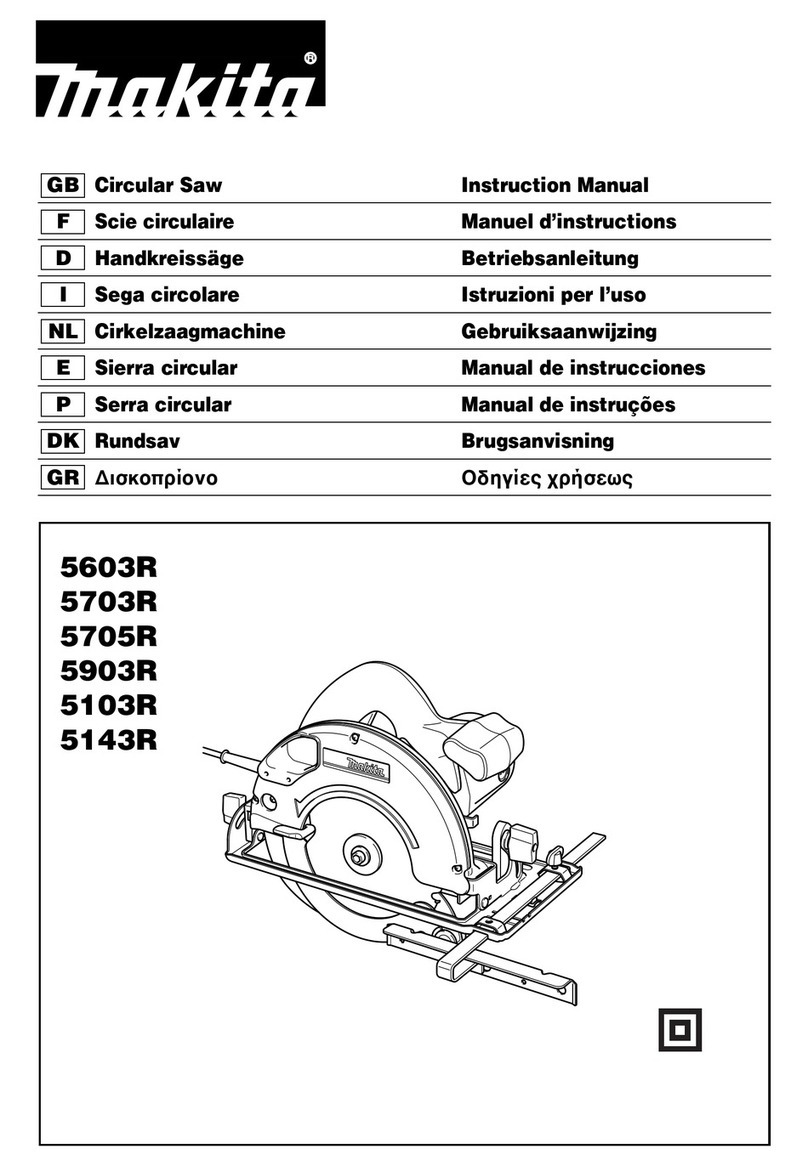
Makita
Makita 5603R User manual
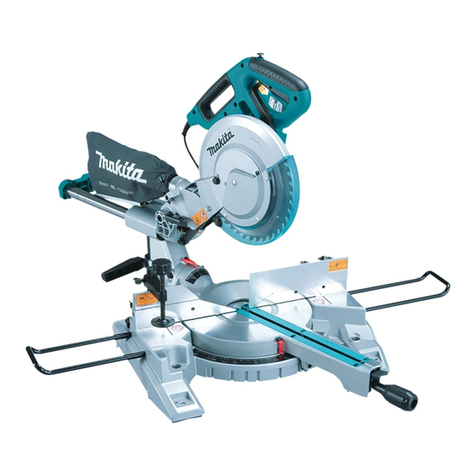
Makita
Makita LS1018 User manual
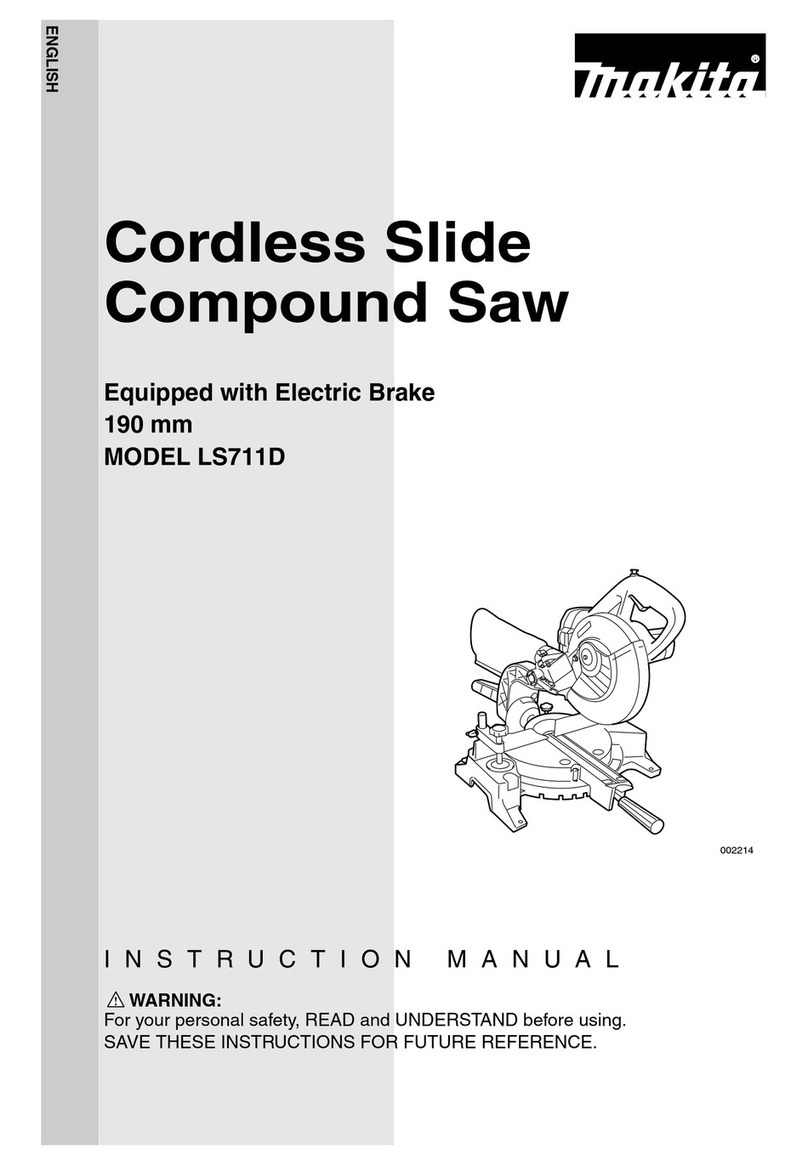
Makita
Makita LS711D User manual

Makita
Makita 5277NB User manual
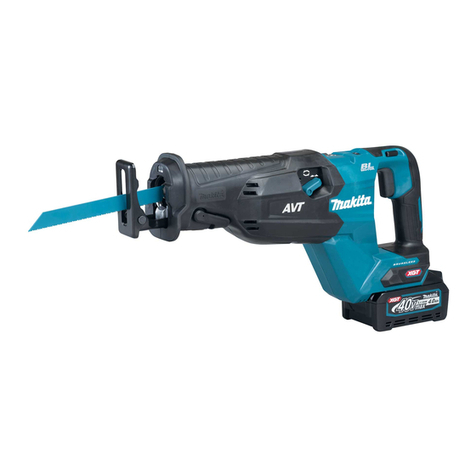
Makita
Makita JR002G User manual
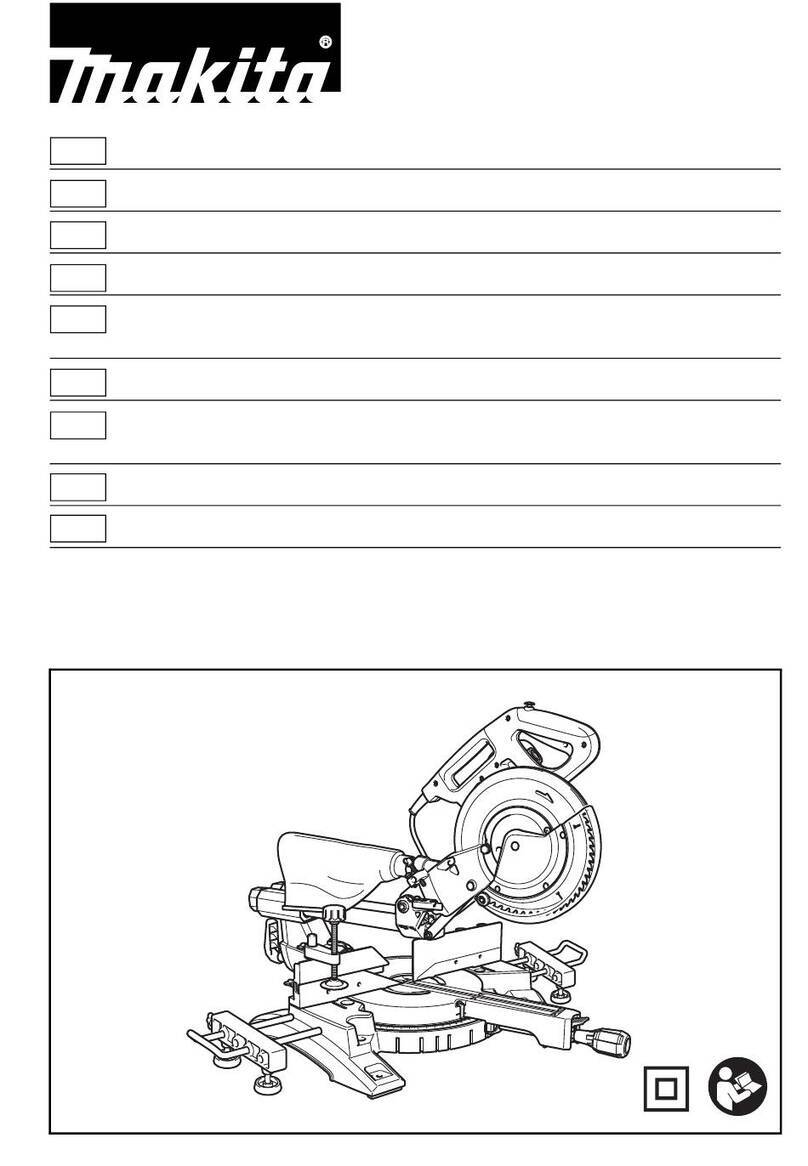
Makita
Makita LS1018LNX4 User manual

Makita
Makita 2414EN User manual

Makita
Makita DJR189 User manual

Makita
Makita LS0815FL User manual
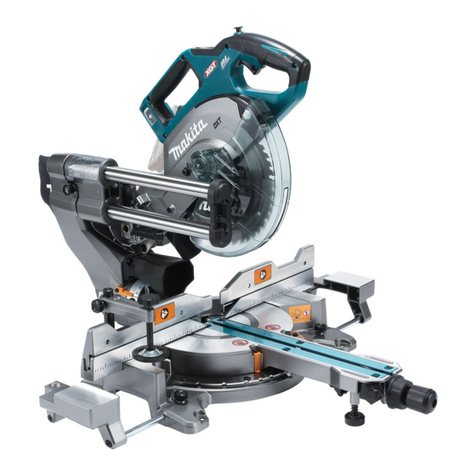
Makita
Makita LS002GZ01 User manual
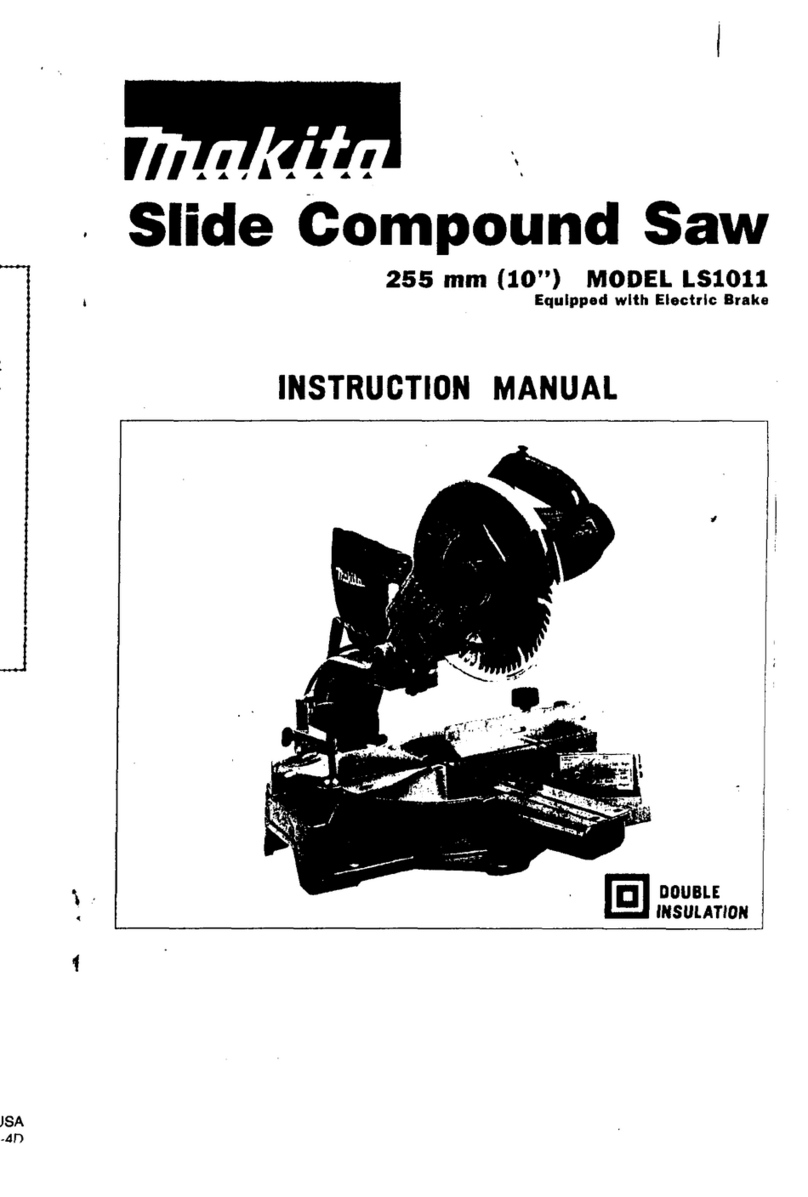
Makita
Makita LS1011 User manual
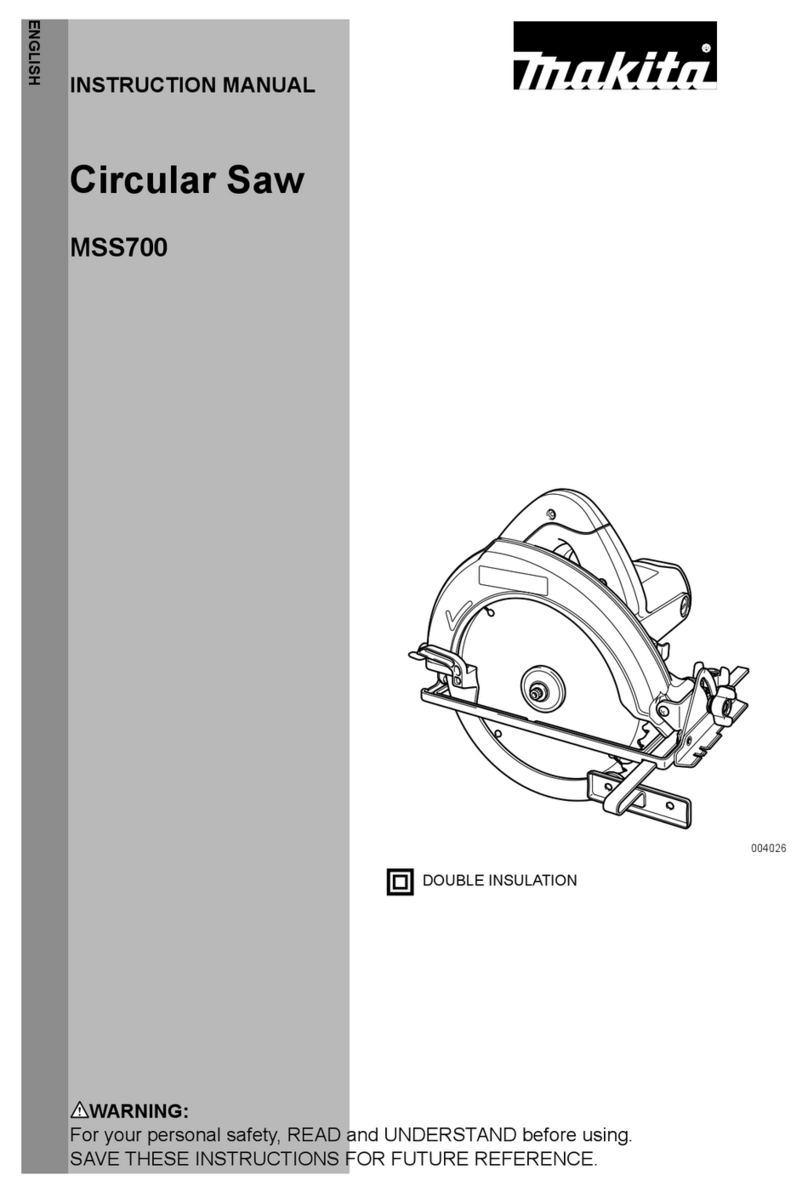
Makita
Makita MSS700 User manual
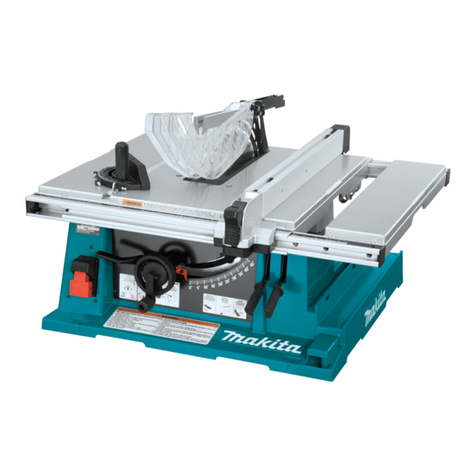
Makita
Makita 2705 User manual

Makita
Makita LH1040 User manual

Makita
Makita LS1400 User manual

Makita
Makita 4200H User manual

Makita
Makita LW1400 User manual
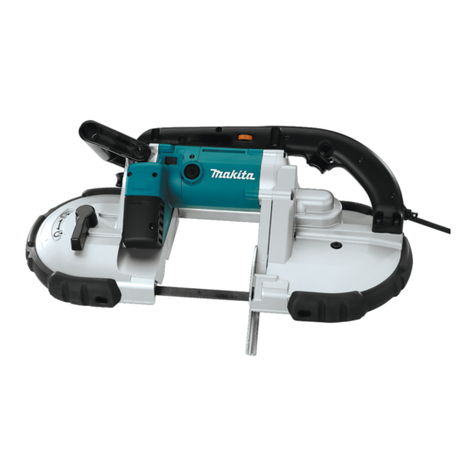
Makita
Makita 2107F User manual
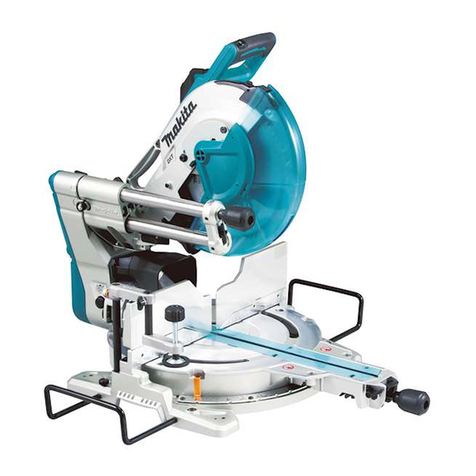
Makita
Makita LS1219 User manual

Makita
Makita LH1201FL User manual
